Broadway (Los Angeles)
Broadway, until 1890 Fort Street, is a thoroughfare in Los Angeles County, California, United States. The portion of Broadway from 3rd to 9th streets, in the Historic Core of Downtown Los Angeles, was the city's main commercial street from the 1910s until World War II, and is the location of the Broadway Theater and Commercial District, the first and largest historic theater district listed on the National Register of Historic Places (NRHP).[2] With twelve movie palaces located along a six-block stretch of Broadway, it is the only large concentration of movie palaces left in the United States.
Broadway Theater and Commercial District (NRHP) Broadway Theater and Entertainment District (City of Los Angeles) | |
%252C_September_2020.jpg.webp) Broadway looking north towards the historic Theater and Commercial District from Hoxton Hotel Roof (11th St.), September 2020 | |
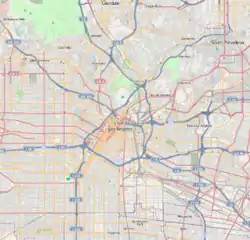 | |
| Location | 300—849 S. Broadway Los Angeles, California |
|---|---|
| Coordinates | 34°2′48″N 118°15′4″W |
| Architect | Multiple |
| Architectural style | Early Commercial, Late 19th And 20th Century Revivals, Art Deco |
| NRHP reference No. | 79000484 [1] |
| Added to NRHP | May 9, 1979 |
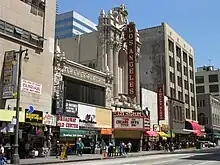 Los Angeles Theatre | |
| Maintained by | |
|---|---|
| Length | 17.75 mi (28.57 km) |
| Location | Los Angeles |
| South end | Main Street in Carson |
| Major junctions |
|
| Northeast end | Mission Road in Los Angeles |
| Construction | |
| Inauguration | 1890 |
Route
South Broadway's southern terminus is Main Street just north of the San Diego Freeway (I-405) in Carson. From there it runs 10 miles (16 km) north through Athens and South Los Angeles to Downtown Los Angeles – at Olympic Blvd. entering downtown's Historic Core, in which the buildings lining Broadway form the Broadway Theater and Commercial District. Crossing 3rd Street, Broadway passes through the Civic Center including Grand Park. After crossing the US-101 (Santa Ana Freeway), signs read "North Broadway" as it enters Chinatown. It then curves northeast, passing through old railyards, crosses the Golden State Fwy. (I-5) and heads due east to its terminus at Mission Road in Lincoln Heights.
History
Founding and extension
Broadway, one of the oldest streets in the city, was laid out as part of the 1849 plan of Los Angeles made by Lieutenant Edward Ord and named Fort Street. Fort Street began at the south side of Fort Moore Hill (a block north of Temple Street) at Sand Street (later California Street).
In 1890, the name of Fort Street, from 1st Street to 10th Street, was changed to Broadway. The rest of Fort Street, from California Street to 1st Street, was changed to North Broadway.[3][4]
Proposal for opening Broadway through to Buena Vista Street (now North Broadway), and extending the street south into what was then part of Main Street, below Tenth Street, in order to give a continuous, wide thoroughfare from the southern city limits to the Eastside, was made as early as February 1891.[5]
The Broadway Tunnel under Fort Moore Hill was opened in 1901, extending North Broadway to Buena Vista Street at Bellevue Avenue (later Sunset Boulevard, now Cesar Chavez Avenue). A section of Broadway in South Los Angeles was originally named Moneta Avenue until 1923.[6]
In 1909, construction on a bridge across the Los Angeles River was begun to connect Buena Vista Street to Downey Avenue, which ran from the river to Mission Road. The names of Buena Vista and Downey were then changed to North Broadway,[7][8][9] but not without significant objections from affected residents and landowners.[10][11][12][13] The bridge, which continued to be referred to as the Buena Vista Street Bridge for a good while, was opened to traffic in late September 1911.[14]
Los Angeles' central commercial and entertainment street
For more than 50 years, Broadway from 1st Street to Olympic Boulevard was the main commercial street of Los Angeles, and one of its premier theater and movie palace districts as well. It contains a vast number of historic buildings and is listed on the National Register of Historic Places.
Prior to the turn of the 20th century, the city's Central Business District was further north, along Spring and Main streets between the Plaza and 2nd Street. In 1895 J.W. Robinson's opened what was then considered a very large and impressive four-story department store at 239 S. Broadway,[15][16] signaling of the shift over the next decade and a half of the main shopping district to Broadway below 2nd Street.
Retail hub
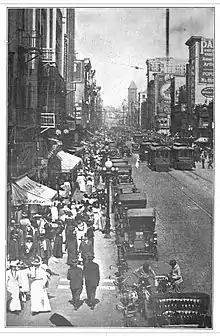
From around 1905 through the 1950s, Broadway was considered the center of the city, where residents went to ornate movie palaces and live theaters, and shopped at major department stores and shops. See the Table of department stores on Broadway and Seventh streets below.
The square footage of the four largest department stores alone — Bullock's at 806,000 sq ft (74,900 m2), The Broadway at 577,000 sq ft (53,600 m2),[17] May Co. at over 1,000,000 sq ft (93,000 m2)[18] and J. W. Robinson's (7th St. at Hope) at 623,700 sq ft (57,940 m2)[19][20] — totaled over three million square feet, the size of American Dream Meadowlands, America's largest mall today.
Among dozens of significant buildings from that era are the Bradbury Building, Ace Hotel Los Angeles, and the Los Angeles Examiner building designed by Julia Morgan.
Some of the movie theaters on the street fell into disuse and disrepair, some were replaced with parking lots, but many have been repurposed and/or restored. The department stores closed in the 1970s and 1980s, but Broadway has been the premier shopping destination for working class Latinos for decades.[21]
Theater District
NRHP refers to the district as the Broadway Theater and Commercial District, while the City of Los Angeles Planning Department refers to the Broadway Theater and Entertainment District.[22]
Highest concentration of movie palaces in the world
Stretching for six blocks from Third to Ninth Streets, the district includes 12 movie theaters built between 1910 and 1931. By 1931, the district had the highest concentration of cinemas in the world, with seating capacity for more than 15,000 patrons. Broadway was the hub of L.A.'s entertainment scene – a place where "screen goddesses and guys in fedoras rubbed elbows with Army nurses and aircraft pioneers."[23] In 2006, the Los Angeles Times wrote:
"There was a time, long ago, when the streets of downtown Los Angeles were awash in neon—thanks to a confluence of movie theaters the world had never seen before. Dozens of theaters screened Hollywood's latest fare, played host to star-studded premieres and were filled nightly with thousands of moviegoers. In those days, before World War II, downtown L.A. was the movie capital of the world."[24]
Columnist Jack Smith called it "the only large concentration of vintage movie theaters left in America."[25] Smith recalled growing up a mile from Broadway and spending his Saturdays in the theaters:
"I remember walking into those opulent interiors, surrounded by the glory of the Renaissance, or the age of Baroque, and spending two or three hours in the dream world of the movies. When I came out again the sky blazed; the heat bounced off the sidewalk, traffic sounds filled the street, I was back in the hard reality of the Depression.[25]
Because Broadway has been used as a filming location for decades, many of these theatre marquees can be seen in classic Hollywood films, including Safety Last! (1923), D.O.A. (1950), The Omega Man (1971), Blade Runner (1982), and The Artist (2011).[26][27]
Revitalization by Spanish-language cinema
In the years after World War II, the district began to decline, as first-run movie-goers shifted to the movie palaces in Hollywood, in Westwood Village, and later to suburban multiplexes. After World War II, as Anglo moviegoers moved to the suburbs, many of the Broadway movie palaces became venues for Spanish-language movies and variety shows. In 1988, the Los Angeles Times noted that, without the Hispanic community, "Broadway would be dead."[28] Jack Smith wrote that Broadway had been "rescued and revitalized" by "the Latino renaissance."[25]
Preservation and renovation efforts
The district has been the subject of preservation and restoration efforts since the 1980s. In 1987, the Los Angeles Conservancy started a program called "Last Remaining Seats" in which the old movie palaces were opened each summer to show classic Hollywood movies.[23][29] In 1994, the Conservancy's associate director, Gregg Davidson, noted: "When we started this, the naysayers said no one will go downtown to an old theater to see an old movie in the middle of the summer, but we get a number of people who have never seen a movie in a theater with a balcony. The older people (go) for nostalgia. And the movie people—seeing a classic film on a big screen is a different experience."[29] After attending a Conservancy screening, one writer noted: "The other night I went to the movies and was transported to a world of powdered wigs and hoop skirts, a rococo fantasy of gilded cherubs and crystal chandeliers. And then the film started."[23]
Despite preservation efforts, many of the theaters have been converted to other uses, including flea markets and churches. The Broadway movie palaces fell victim to a number of circumstances, including changing demographics and tastes, a downtown location that was perceived as dangerous at night, and high maintenance costs for aging facilities. With the closure of the State Theater in 1998, the Orpheum and the Palace were the only two still screening films.[30]
In 2006, the Los Angeles Times wrote: "Of all of L.A.'s many hidden gems, maybe none is as sparkling nor as hidden as the Broadway theater district downtown."[23] Bemoaning the possible loss of such gems, the same writer noted: "L.A. gave birth to the movies. To lose the astonishing nurseries where the medium grew up would be tragic."[23]
Broadway since 2008
In 2008, the City of Los Angeles launched a $40-million campaign to revitalize the Broadway district, known as the "Bringing Back Broadway" campaign. Some Latino merchants in the district expressed concern that the campaign was an effort to spread the largely Anglo gentrification taking hold in other parts of downtown to an area that has become the city's leading Latino shopping district.[31] A worker at one of the district's bridal shops noted, "On one side, I like the idea. The only thing is that I don't think they want our types of businesses."[31]
The Downtown's real estate revitalization, using the City's adaptive reuse ordinance that makes it easier for developers to convert outmoded and/or vacant office and commercial buildings into residential buildings, has reached the Broadway Historic District. It includes the transformation of the United Artists Theater office tower into the Ace Hotel Los Angeles, and restoration of its movie palace.
The Bringing Back Broadway commission is working on further reviving the landmark Los Angeles boulevard in the historic district. Led by City Councilman Jose Huizar, the commission has recommended widening sidewalks, eliminating traffic lanes, constructing new parking structures, and bringing back streetcar service reminiscent of the street's past.[32] A pedestrian-friendly project finished up in December 2014 that widened the sidewalks and replaced the parking lane with planters, chairs and round cafe tables with bright-red umbrellas. The Great Streets Initiative seeks to bolster the street-level health of the city by making several dozen boulevards more hospitable to pedestrians, cyclists and small businesses. Mayor Eric Garcetti said the effort represents "a shift from the way that our neighborhoods have been planned in Los Angeles," with a new focus on "walkability and transit."[33]
Broadway retail is transitioning from a broad mix of stores catering to Hispanic immigrants and a burgeoning sneaker and streetwear retail cluster has emerged from 4th to 9th streets: Sneaker Row.[34]
Retail in and around the Eastern Columbia, located at the intersection of 9th Street & Broadway, has proliferated in recent years with the opening of Acne Studios, Oak NYC, Aesop, Tanner Goods, BNKR, Austere, A.P.C., and Urban Outfitters located in the Rialto Theater (Los Angeles Historic-Cultural Monument No. 472).[35][36]
Buildings and sites
All landmarks in geographic order, north to south:
North of Hollywood Freeway
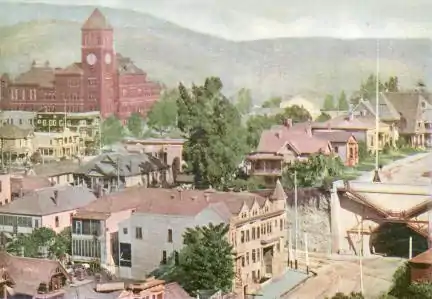 Broadway Tunnel at Fort Moore Hill, built 1901, southern entrance at (lower right), with Los Angeles High School which stood on Fort Moore Hill 1891–1917 (upper left)
Broadway Tunnel at Fort Moore Hill, built 1901, southern entrance at (lower right), with Los Angeles High School which stood on Fort Moore Hill 1891–1917 (upper left)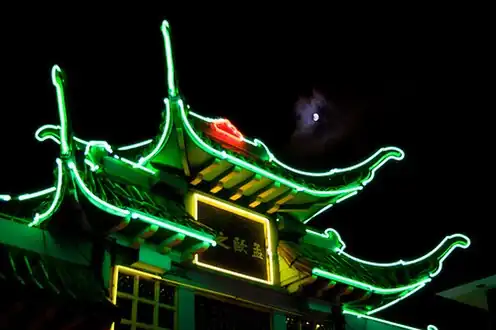 East Gate of New Chinatown. 943 N. Broadway
East Gate of New Chinatown. 943 N. Broadway
- Little Joe's (razed), 904 N. Broadway, Chinatown
- Site of Broadway Tunnel (1901–1941, demolished) below Fort Moore Hill (leveled), between today's Temple St. and César Chávez Bl.
Hollywood Freeway to Temple
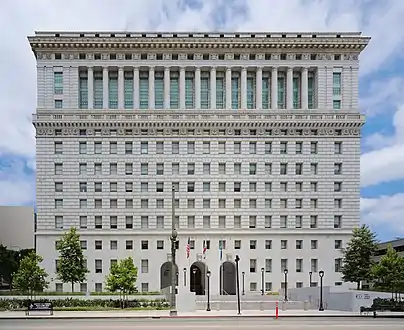 Front-on view, Hall of Justice (1925)
Front-on view, Hall of Justice (1925)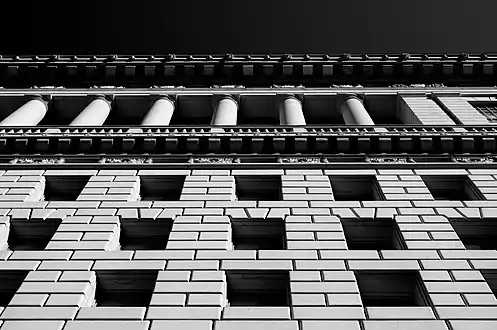 Façade, Hall of Justice
Façade, Hall of Justice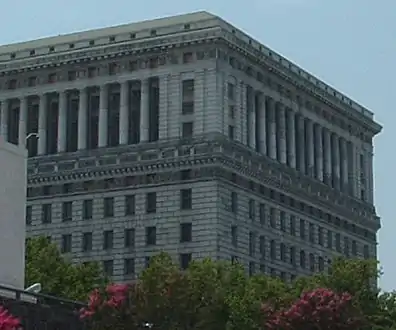 Corner view, Hall of Justice
Corner view, Hall of Justice
This area south to Second Street is now the Civic Center, as well as the site of the Central Business District during the 1880s and 1890s)
- L. A. County Hall of Justice (1925)
.jpg.webp) 1905 view south on Broadway from north of Temple Street. The Times Mirror printing house in foreground, marked 110 N. Broadway, now site of the Hall of Justice. Towers of the 1888 City Hall on the 200 block of S. Broadway in the distance. Fort Moore Hill, now leveled, at right.
1905 view south on Broadway from north of Temple Street. The Times Mirror printing house in foreground, marked 110 N. Broadway, now site of the Hall of Justice. Towers of the 1888 City Hall on the 200 block of S. Broadway in the distance. Fort Moore Hill, now leveled, at right..jpg.webp) c.1893–1900, looking east along Third St. from Olive St. on Bunker Hill. 3 buildings stand out from left to right: the 1888 City Hall (Broadway between 2nd/3rd), the Stimson Block (3rd & Spring), and the Bradbury Building (3rd & Broadway)
c.1893–1900, looking east along Third St. from Olive St. on Bunker Hill. 3 buildings stand out from left to right: the 1888 City Hall (Broadway between 2nd/3rd), the Stimson Block (3rd & Spring), and the Bradbury Building (3rd & Broadway)
Temple and Broadway
Cable cars of the Temple Street Cable Railway ran along Temple Street starting in 1886 and were replaced with Pacific Electric streetcars in 1902.[37][38]
Northwest corner of Temple and Broadway
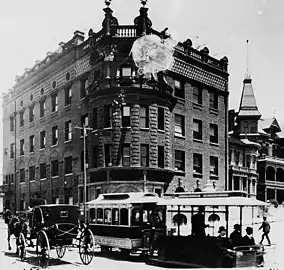 The Women's Christian Temperance Union Temple and a Temple Street Cable Railway car, 1890
The Women's Christian Temperance Union Temple and a Temple Street Cable Railway car, 1890
- The three-story brick Women's Christian Temperance Union building was erected in 1888 for $45,000.[39] Also known as the Temperance Temple, it has been demolished[40] and was replaced in 1957 by the Los Angeles County Central Heating and Refrigeration Plant.[41]
Southeast corner of Temple and Broadway (Pound Cake Hill, west side of New High St.)
 Los Angeles High School
Los Angeles High School
on Pound Cake Hill, 1870s_(14783523833).jpg.webp) "Red Stone" Courthouse and Post Office (1891-1936)
"Red Stone" Courthouse and Post Office (1891-1936)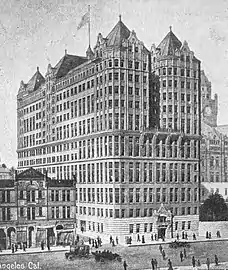 Hall of Records, adjacent to Courthouse on the south (1911–1973)
Hall of Records, adjacent to Courthouse on the south (1911–1973)
This location was at the time known as Pound Cake Hill. The buildings located here faced New High Street to their east and Broadway to their west. They were as follows:[42]
- Los Angeles High School, whose original location (1873-1887) was between New High on the west and Broadway on the east, south of Temple Street. It was moved to California and Sand streets, and in 1890 a new facility was built on Fort Moore Hill, immediately north of where Broadway today crosses the Hollywood Freeway. The Pound Cake Hill school was demolished and replaced by:
- First, the Red Stone Courthouse (or "Red Sandstone Courthouse"), which took over the function of courthouse from the Clocktower Courthouse (also called the Temple Courthouse). It was damaged beyond repair by Long Beach earthquake of 1933 and was torn down in 1936.
- The Los Angeles County Hall of Records was built next to (south of) the Red Sandstone Courthouse in 1911, After the 1971 San Fernando earthquake, it was determined to be unsafe and it was demolished in 1973. A new Hall of Records was built and opened in 1962, one block west on the south side of Temple between Broadway and Hill.
Currently on the site are:
- Clara Shortridge Foltz Criminal Justice Center (Los Angeles County Grand Jury)
- A portion of Grand Park, which stretches mid-block between Temple and First, from City Hall at Spring Street, to the Music Center at Grand Avenue.
Realignment of Spring Street (1925)
The Poundcake Hill buildings originally backed up to Broadway to their west, and faced New High Street to their east. New High Street (see Sanborn map above) was a north-south street that ran parallel to Broadway, and to Spring Street to its east. As part of the construction of City Hall in the early 1920s, New High Street was removed south of Temple, and Spring Street was realigned more towards a north-south orientation, parallel with Broadway, instead of running more northeasterly and meeting Main Street at Temple Street. As a result the Poundcake Hill buildings faced the newly aligned Spring Street until they were demolished.
Southwest corner of Temple and Broadway
- The second location of the Los Angeles County Hall of Records, opened 1962.
Adjacent to the south, mid-block, is a portion of Grand Park.
First and Broadway
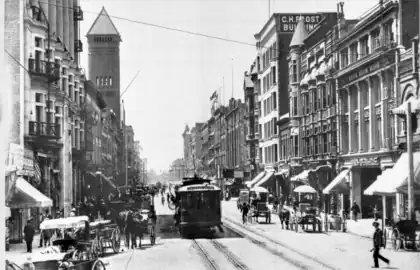 Looking south along Broadway from First Street, 1904-5. At right, from left to right: C.H. Frost Building (#145), 141-3, the turreted Roanoke Bldg (#137-9), Newell & Gammon Bldg. (#131-5), Mason Opera House (#125-9)At left Chamber of Commerce (#128), 1888 City Hall (#228-238).
Looking south along Broadway from First Street, 1904-5. At right, from left to right: C.H. Frost Building (#145), 141-3, the turreted Roanoke Bldg (#137-9), Newell & Gammon Bldg. (#131-5), Mason Opera House (#125-9)At left Chamber of Commerce (#128), 1888 City Hall (#228-238).
Northeast corner of First and Broadway
%252C_photo_about_1887.jpg.webp) 1886 Los Angeles Times Building
1886 Los Angeles Times Building
- Los Angeles Times 1886 building. This building was razed after a 1910 bombing and a new headquarters was opened on this site in 1912. The newspaper later moved further south on Spring Street to the Los Angeles Times building, now part of Times Mirror Square, occupying the entire block between Broadway, Spring, First and Second streets.[43]
Northwest corner of First and Broadway
- Site of the Tajo Building (1896–mid-20th c.).[44] Now the location of the Los Angeles County Law Library.[45]
Southeast corner of First and Broadway and east side of 100 block
 1973 Pereira Addition building, Times Mirror Square
1973 Pereira Addition building, Times Mirror Square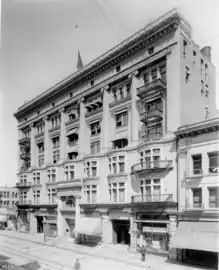 1900s view of Chamber of Commerce, 128 S. Broadway
1900s view of Chamber of Commerce, 128 S. Broadway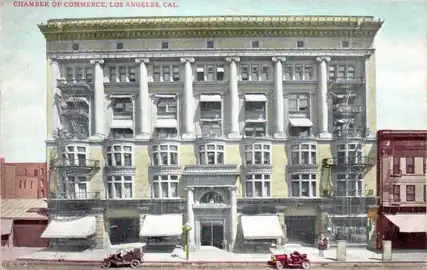 Postcard c.1910 of Chamber of Commerce, 128 S. Broadway
Postcard c.1910 of Chamber of Commerce, 128 S. Broadway
- Site of the Culver Block retail and office building.[46] Now the site of the Times Mirror Square 1973 Pereira Addition, so called because it was designed by William Pereira.
- South of the Culver Block was the Los Angeles Chamber of Commerce building, 128–130 S. Broadway, opened February 12, 1904,[47] a landmark at the time featured on postcards and in books. 6 stories, 4 floors. Ground floor offices included those of the Los Angeles Herald and Consolidated Bank.[48]
Southwest corner of First and Broadway
 Mason Opera House or Mason Theatre
Mason Opera House or Mason Theatre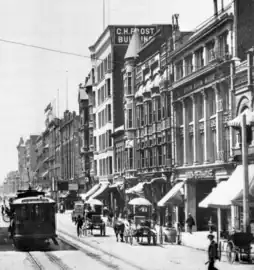 C.H. Frost Building at 145 S. Broadway, c.1904-5. To its right, the turreted Roanoke Bldg. (#137-9), Newell & Gammon Bldg. (#131-5), and the Mason Opera House (#125-9).
C.H. Frost Building at 145 S. Broadway, c.1904-5. To its right, the turreted Roanoke Bldg. (#137-9), Newell & Gammon Bldg. (#131-5), and the Mason Opera House (#125-9).
The southwest corner, during Victorian times the site of unremarkable retail and office buildings, was from 1958 the location of the State Office Building, (1958-60, architect Anson C. Boyd, razed 2006). It was named the Junipero Serra State Office Building, and this moniker would be transferred to the former Broadway Department Store building at 4th and Broadway when it was opened to replace this building in 1998.[49] It is now the location of the New U.S. Courthouse built in 2016, taking up the entire block between Broadway, Hill, First and Second.[50]
Just south of the southwest corner was the Mason Theatre, 127 S. Broadway. Opened in 1903 as the Mason Opera House, 1,600 seats. Benjamin Marshall of the Chicago firm Marshall & Wilson designed the building in association with John Parkinson. Marshall is known for designing the Iroquois Theatre in Chicago. Remodeled in 1924 by Meyer & Holler. Later, as the Mason Theatre, it showed Spanish-language films. Demolished 1955.[51]
145 S. Broadway,[52]site of the C. H. Frost Building, later known as the Haig M. Prince Building. Built 1898, architect John Parkinson,[53] Now the location of the new United States Courthouse built in 2016, taking up the entire block between Broadway, Hill, First and Second.[50]
Second and Broadway
.jpg.webp) Broadway looking south from 2nd St., 1895-1905. The 1888 City Hall is visible on the left (east) side.
Broadway looking south from 2nd St., 1895-1905. The 1888 City Hall is visible on the left (east) side. Another view of Broadway looking south from 2nd St. showing a cable car, c.1893-1895
Another view of Broadway looking south from 2nd St. showing a cable car, c.1893-1895
Northeast corner of Second and Broadway
 The 2nd & Broadway Hellman Building in 1918
The 2nd & Broadway Hellman Building in 1918
One of several “Hellman Buildings” across Downtown L.A. — not to be confused with the still-existing Hellman Building at Fourth and Spring — was located here (#138) from 1897 to 1959.[54] The site is now a parking structure, part of the Times Mirror Square complex.
Southwest corner of Second and Broadway and the west side of the 200 block
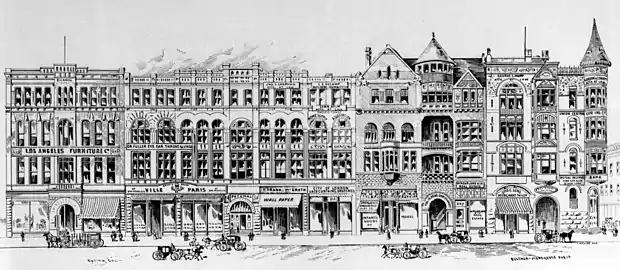 West side of Broadway from #229 (at left) to #207 (at right, SW corner of 2nd St.) sometime after 1894. From left to right: Bicknell Block with the Los Angeles Furniture Co.; Potomac Block with Ville de Paris and City of London stores, the YMCA building with its turret and two gables, and the American National Bank building.
West side of Broadway from #229 (at left) to #207 (at right, SW corner of 2nd St.) sometime after 1894. From left to right: Bicknell Block with the Los Angeles Furniture Co.; Potomac Block with Ville de Paris and City of London stores, the YMCA building with its turret and two gables, and the American National Bank building.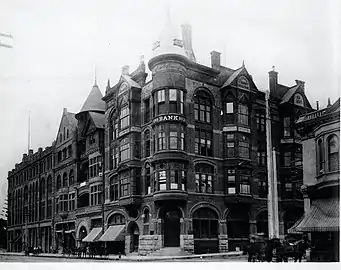 American National Bank (later California Bank) Building (1878-1911), southwest corner, 1890. To the viewer's left (south) are the turret and two gables of the YMCA Building (1889), then the Potomac Block (1890).
American National Bank (later California Bank) Building (1878-1911), southwest corner, 1890. To the viewer's left (south) are the turret and two gables of the YMCA Building (1889), then the Potomac Block (1890)..jpg.webp) Merchants Trust Company Building in 1910
Merchants Trust Company Building in 1910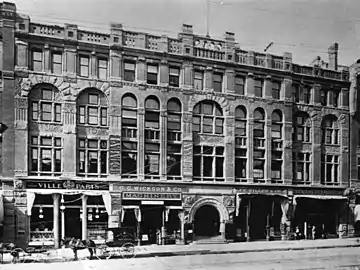 Potomac Block c.1890-1895.
Potomac Block c.1890-1895.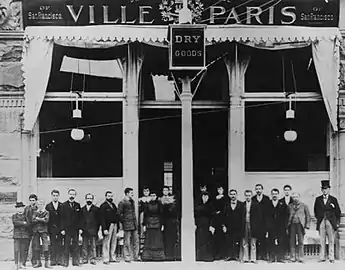 The Ville de Paris department store, 1901
The Ville de Paris department store, 1901 Boston Dry Goods and Harris Newmark buildings, 1899
Boston Dry Goods and Harris Newmark buildings, 1899
The west side of the 200 block of South Broadway had a key place in the retail history of Los Angeles from the 1893 through 1917, as it was home to several prominent early department stores such as the Ville de Paris, Coulter's department store from 1905–1917, and J. W. Robinson's "Boston Dry Goods" store from 1895–1915. All three stores would move to Seventh Street when it became the upscale shopping street between 1915 and 1917.
- On the southwest corner of 2nd and Broadway was Judge O'Melveny's house, built in 1870. This was replaced by the American National Bank (later California Bank) Building, which one turn was replaced by the California Building in 1911. Nos. 201-213 Broadway are now known named the Broadway Media Center.
Further south on the west side of Broadway, was 207–211, location of the:
- YMCA Building (#207–209–211), Romanesque Revival architecture, opened in July 1889, demolished in 1903.
- The YMCA operated here at #207 from 1889 until 1903,
- City of London opened here in August 1891, run by Messrs. Hiles and Niccolls, who came from the City of Paris department store. It carried curtains, window shades, comforters, and the like.[55] It operated here until August 1895, when it moved next door to the Potomac Block at #213.[56]
The YMCA Building was demolished to make way for the:
- Merchants Trust Co. Building.[57]
Coulter's complex: Potomac and Bicknell blocks
The adjacent Potomac Block and Bicknell Block originally housed prominent retailers of the day, then were joined together in 1906 by Coulter's department store to form a complex, opening it as a new, 157,000 sq ft (14,600 m2) store in June, 1905.[58][59][60]
Potomac Block
The Potomac Block, 213–223 S. Broadway, was from 1905 to 1917 known as the B. F. Coulter Building. It was originally developed by lumberyard and mill owner J. M. Griffith. It was designed in 1888 by Block, Curlett and Eisen in Romanesque architectural style[61] and opened on July 17, 1890.[62]
Tenants included:
- Ville de Paris department store (at 221–223, from 1893 through 1906),[61]
- City of London Dry Goods Co., which moved here from next door at #211 in August 1895 and advertised for this location through August 1899.[56]
It was the first time major retail stores opened on South Broadway, in what would be a shift of the upmarket shopping district from 1890 to 1905 from around First and Spring to South Broadway. In 1904, Coulter's bought the Potomac Block, and combined it with the Bicknell block to create its new store that opened in 1905.
After Coulter's moved:
- 215 continued as a branch of Coulter's through 1927. Then, 215–217 was home to the Pacific Furniture House in the 1940s.
- 219 housed Fisch's Department Store in the 1940s.
The building was demolished in 1953 and is still the site of a parking lot.[63]
Bicknell Block
The Bicknell Block (or Bicknell Building) at 225–229 S. Broadway, with back entrances at 224–228 S. Hill Street. was part of Coulter's from 1905 from 1917. After Coulter's moved in 1917, it housed the Western Shoe Co. (through 1922), later known as the Western Department Store (1922–1928). Lettering covered the face of the building from top to bottom through the end of the 1950s: "THE LARGEST SHOE DEPT. IN THE WEST".[64]
Further south on Broadway
- 231-235, the Harris Newmark Building (1899, Abram Edelman), Bartlett Music Co. (#233), annex to J. W. Robinson's (#235); Goodwill Industries store (#233-235, 1950s–60s). The building still stands, but all floors except the ground floor have been removed.
- 237-241, the Boston Dry Goods Building (completed 1895, demolished, architects Theodore Eisen and Sumner Hunt, designer of the Bradbury Building)[65][66] The building was home to J. W. Robinson's "Boston Dry Goods" store from 1895 to 1915, Scott's Department Store (239–241, 1920s), Third Street Store (237–241, 1950s–60s). Demolished, currently the site of a parking lot.
- 251 was home to the I. Magnin speciality department store, which opened here on January 2, 1899;[67] starting 1904, I. Magnin announced that the store would be known by the name of its manager, Myer Siegel.[68]
Southeast corner and east side of Broadway from 2nd to 3rd
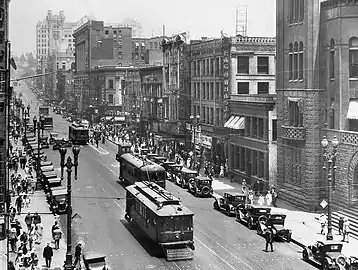 Looking north along Broadway at its east side past 2nd Street. From top left: The L.A. Times Bldg. with castle-like turret, with the 1911 Hall of Records behind it. The Chamber of Commerce Bldg. at #128. Drugstore in the Hellman Bldg. (#144–6) at the NE corner of 2nd Street. Dentist in the Nolan, Smith and Bridge Bldg. (#200–4) at the SE corner of 2nd. New King Hotel in the Gordon Bldg. (#206–10). Victor Clothing in its location from 1926 to 1964 in the Crocker Bldg. (#212–6). Pig 'n Whistle in the Copp Bldg. (#218–224). 1888 City Hall at far right
Looking north along Broadway at its east side past 2nd Street. From top left: The L.A. Times Bldg. with castle-like turret, with the 1911 Hall of Records behind it. The Chamber of Commerce Bldg. at #128. Drugstore in the Hellman Bldg. (#144–6) at the NE corner of 2nd Street. Dentist in the Nolan, Smith and Bridge Bldg. (#200–4) at the SE corner of 2nd. New King Hotel in the Gordon Bldg. (#206–10). Victor Clothing in its location from 1926 to 1964 in the Crocker Bldg. (#212–6). Pig 'n Whistle in the Copp Bldg. (#218–224). 1888 City Hall at far right
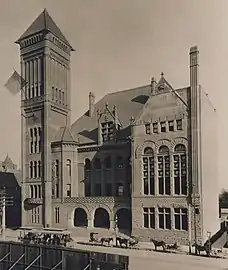 Los Angeles City Hall (1888–1928, demolished)
Los Angeles City Hall (1888–1928, demolished)%252C_then_called_Fort_Street%252C_Los_Angeles.png.webp) B'nai B'rith Temple (opened 1873), the city's first synagogue
B'nai B'rith Temple (opened 1873), the city's first synagogue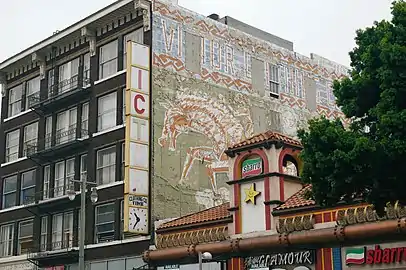 Victor Clothing building, #242
Victor Clothing building, #242
The southeast corner of 2nd and Broadway was the site of
- The First Presbyterian Church was located here in 1894.[69] The church was replaced sometime before 1906 by the:
- Nolan, Smith and Bridge Building, #200-4 S. Broadway, stores and a restaurant.[70]
- Now the corner is the site of the Historic Broadway underground light rail station, under construction.
Mid-block were:
- Crocker Building, #212–6[71] Home to Victor Clothing from 1920 to 1964
- B'nai B'rith Temple (1873), 214 S. Broadway (post-1890 numbering), the city's first synagogue, razed to make way for the Copp Building, 218–224 S. Broadway, home to the original (1908) Pig 'n Whistle candy shop and tea room.[72] The Pig 'n Whistle would open locations at 7th and Broadway and in Hollywood, where it would become a landmark restaurant that still operates today.
- City Hall (1888–1928; opened 1888, demolished 1929; 228–238 S. Broadway, architect Solomon Irmscher Haas, Romanesque Revival). Now a parking lot. Three stories, it had a 150-foot (46 m) campanile. Red and brown brick. Housed the Los Angeles Public Library for a time until it moved to the new Hamburger's department store building at Eighth and Broadway in 1908.[73] The site is now part of the "(213) S. Spring" parking garage.[45]
- #240-246 the Hosfield Building, location of the Natatorium (indoor swimming pool) in 1894 and the Imperial Restaurant in 1906.[71] After 1964, location of Victor Clothing, notable for its changing murals reflecting local Chicano culture. Victor Clothing operated here until 2001, and was known i.a. for its frequent ads on Spanish-language television.[74]
Third and Broadway
Northwest corner of Third and Broadway
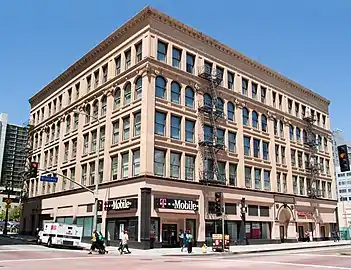 Pan American Lofts (built 1895)
Pan American Lofts (built 1895)
The corner is home to one of the oldest buildings outside the Plaza area, the 1895 Irvine Byrne Block or Byrne Block; now called the Pan American Lofts. The architect was Sumner Hunt. It was built in a hybrid Spanish Colonial Revival/Beaux-Arts style.
The building was home to the renowned I. Magnin clothing store that opened here on January 2, 1899;[75] on June 19, 1904, I. Magnin announced that the Los Angeles store would henceforth be known as Myer Siegel.[68] After a fire at the Irvine Byrne Building destroyed its store on February 16, 1911, Myer Siegel moved further south on Broadway.
It was modernized and converted to lofts in 2007 and given its present name. The halls and staircase have appeared in many of Alfred Hitchcock's movies, Brad Pitt's Se7en, Fight Club, Blade Runner, and other TV shows and commercials.[76]
From Third Street south to Olympic Blvd. (originally Tenth St.), and from Hill Street east to Los Angeles Street, including Broadway, is the Historic Core district, the city's main commercial and entertainment area in the first half of the 20th century.
Northeast corner of Third and Broadway
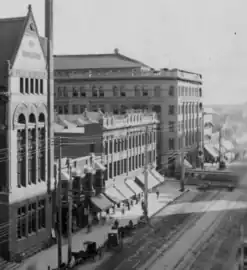 East side of Broadway looking south past 3rd St, c.1903-4. From left to right 1888 City Hall (with flag), Rindge Block at NE corner of 3rd, Bradbury Building
East side of Broadway looking south past 3rd St, c.1903-4. From left to right 1888 City Hall (with flag), Rindge Block at NE corner of 3rd, Bradbury Building%252C_Rindge_Block_at_NE_corner_of_3rd%252C_Bradbury_Building.jpg.webp) East side of Broadway looking north past 3rd St, c.1888. From left to right 1888 City Hall (with flag), Rindge Block at NE corner of 3rd, Bradbury Building
East side of Broadway looking north past 3rd St, c.1888. From left to right 1888 City Hall (with flag), Rindge Block at NE corner of 3rd, Bradbury Building
On this corner:[77]
- Originally the J. C. Graves house stood here; Graves bought the property in 1879 for $2,250. The house was sold and removed to 10th and Hope streets in 1888.
- Rindge Block (1898, sold in 1899 for $190,000 to Frederick H. Rindge, the "King of Malibu"), 248–260 S. Broadway, commercial building; the top floors were removed and only the ground floor remains.
Southwest corner of Third and Broadway
 Entrance area, Million Dollar Theatre
Entrance area, Million Dollar Theatre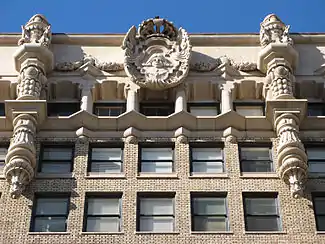 Roofline, Million Dollar Theatre
Roofline, Million Dollar Theatre Detail, side, Million Dollar Theatre
Detail, side, Million Dollar Theatre
- Million Dollar Theatre, (1917-8, architects Albert C. Martin and William Lee Woollett, Spanish Baroque Revival style, 2,345 seats), 307 S. Broadway. It is the northernmost of the movie palaces that comprise the Broadway Theater District and is listed in the National Register of Historic Places.[78] Built by Sid Grauman who would later open Grauman's Chinese Theatre in Hollywood. The theater was designed by architects with a fanciful facade in the Churrigueresque style. After more than 30 years as one of the city's most prestigious first-run movie palaces, the Million Dollar Theater presented Spanish-language films and variety shows from 1950 until the late 1980s. The theater had a seating capacity of 2,345 when it opened in 1918.[79] In 1925, Ben-Hur played for six months at the Million Dollar Theater.
Southeast corner of Third and Broadway
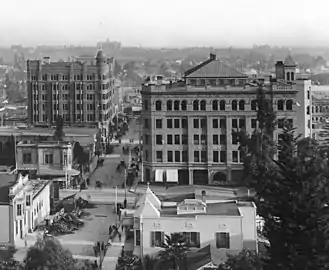 View from Bunker Hill to Bradbury Building and the Stimson Block at 3rd & Spring. The Pan American Lofts had not yet been built on the NW corner of 3rd & Broadway. Around 1894–5.
View from Bunker Hill to Bradbury Building and the Stimson Block at 3rd & Spring. The Pan American Lofts had not yet been built on the NW corner of 3rd & Broadway. Around 1894–5.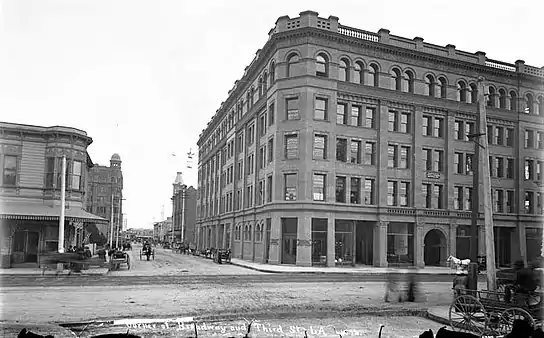 Bradbury Building in 1894, then anchoring the southwestern end of the business district[80]
Bradbury Building in 1894, then anchoring the southwestern end of the business district[80] Bradbury Building in 1960
Bradbury Building in 1960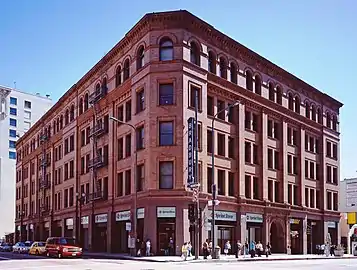 Bradbury Building exterior, 2005
Bradbury Building exterior, 2005 Atrium of the Bradbury Building
Atrium of the Bradbury Building
- Bradbury Building (1893, architects Sumner Hunt and George Wyman, Italian Renaissance Revival, Romanesque Revival, and Chicago School styles), the oldest remaining commercial building in Downtown Los Angeles. The Los Angeles Conservancy calls it an icon and a "unique treasure". Commissioned by gold-mining and real estate millionaire Lewis Bradbury. It is famous for its light-filled atrium, open cage elevators, marble stairways and ornate iron railings, and has appeared in many films including Blade Runner.[79]
Third to Fourth
South of the intersection of Third and Broadway, sites of interest include:
West side
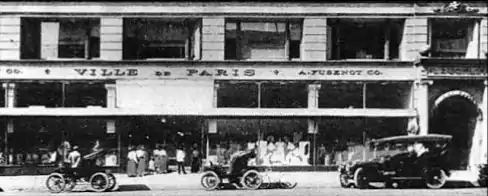 Ville de Paris department store in the Homer Laughlin Building, c. 1905
Ville de Paris department store in the Homer Laughlin Building, c. 1905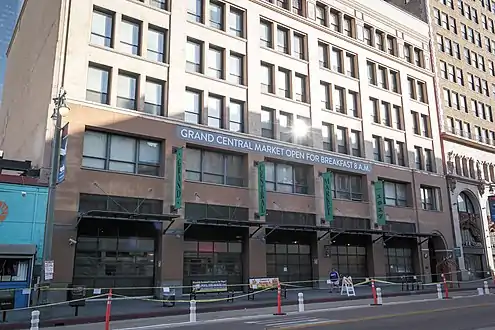 Homer Laughlin Building in 2014
Homer Laughlin Building in 2014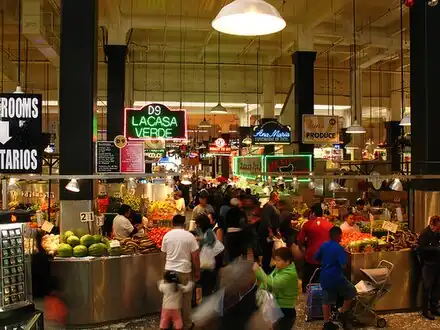
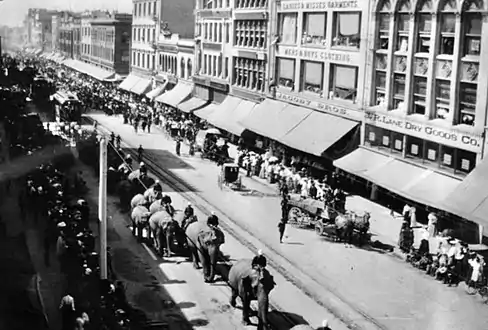 West side of the 300 block during a Ringling Bros. circus parade in 1905, showing Jacoby Bros. and J. R. Lane stores.
West side of the 300 block during a Ringling Bros. circus parade in 1905, showing Jacoby Bros. and J. R. Lane stores.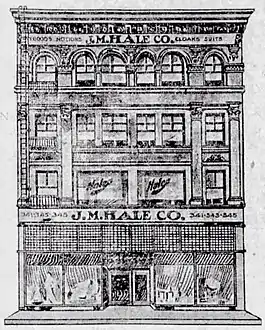 J. M. Hale Co.'s new store at 341–5 Broadway, 1909
J. M. Hale Co.'s new store at 341–5 Broadway, 1909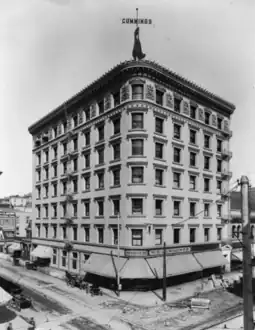 Cummings shoe store, Grant Block, NW corner of 4th, c. 1902
Cummings shoe store, Grant Block, NW corner of 4th, c. 1902
- #317: Homer Laughlin Building (1896, John Parkinson), 317 S. Broadway, home to Grand Central Market since 1917. Previously home to department stores: Coulter's (1898–1905) and Ville de Paris (1905–1917).
- Former J. R. Lane Dry Goods store, 327–329 S. Broadway, (successors to Crandall and Lane) located here through the 1910s. Later, this was the location of Field's jewelry store and the Broadway food market. Still standing, now a food court, but top floors were removed; now single story only.[45]
- #331–5: Former Jacoby Bros. department store, 331–3–5 S. Broadway, from 1900 to 1935. At 60,000 square feet (5,600 m2) over four floors plus a basement, it was stated at its opening in 1900 that it had the largest selection of clothing and of shoes in the Western United States.[81] Architect John B. Parkinson.[82] The building was home to an independent "Boston Store" department store in the late 1930s; no relation to J.W. Robinson's or the later regional chain by the same name.[83] Currently independent retail. 2 of 4 floors were removed. Replaced the First Methodist Episcopalian Church previously located here, which moved to the northeast corner of 6th & Hill.[84] Still standing, but top floors were removed; two floors remain.[45]
- #337–9: former Haggarty's department store from 1905[85] to 1917.[86]
- #341–3–5: former J. M. Hale department store from 1909[87] through the 1920s.
- #351: Site of The Wonder, 351 S. Broadway, opened in 1921, was the largest retail silk store in the U.S.[88]
- #355–363: Grant Building (originally called the "Grant Block", 1898, 3 stories,[89] enlarged to 7 stores 1901–2 by John Parkinson,[90] now two stories) at 363 S. Broadway, northwest corner of 4th Street. Once seven stories tall, all but the first two floors have been removed.[91] It was home to the W. E. Cummings shoe store, which had a large shoe on the roof of the building, serving as a landmark, then, from 1908, a Montgomery Bros. jewelry store, one of the most prominent in the city at the time.[92] The building also housed the Philippine Consulate General in Los Angeles from its establishment from 1947 to 1952.[93]
East side
- Blackstone Building (not to be confused with the later Blackstone Department Store building at 901 S. Broadway), 318–322 S. Broadway (1907),[94] housed Blackstone's Department Store from 1907 to 1917, as well as the Los Angeles County Library and the Cozy Theater. Originally 5 stories, now 3.[95]
- Trustee Building (1905, Parkinson and Bergstrom),[94] 340 S. Broadway, home to various retail stores including Columbia Outfitting in the 1920s.
- O. T. Johnson Block (1895, Robert Brown Young, 3 stories)[96] All but one floor have been removed.[45]
- O. T. Johnson Building (1902, John Parkinson, Romanesque, 7 stories),[96] 356–364 S. Broadway, NE corner of 4th/Broadway.[97][98] All but two floors have been removed.[45]
West side
- former The Broadway dept. store, now the Junípero Serra state office bldg., 320 W. 4th St. (SW corner of Broadway)
- former Woolworth's five and dime, 431 S. Broadway
.jpg.webp)
- Metropolitan Building, former home of Owl Drug Co., (1914–1934), L.A. Public Library (1913–1926), J. J. Newberry five and dime (1939-1990); 315 W. 5th (NW corner of Broadway)
East side
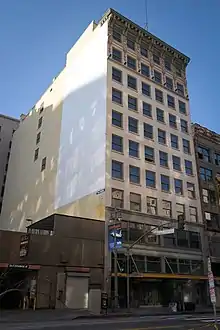 Judson C. Rives Building (1907) at #424
Judson C. Rives Building (1907) at #424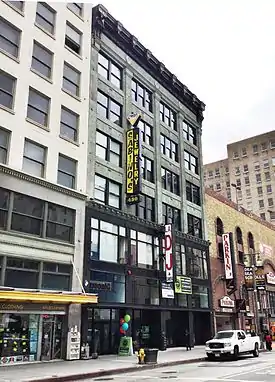 Bumiller Building at #430, home to the Bon Marché department store in 1906
Bumiller Building at #430, home to the Bon Marché department store in 1906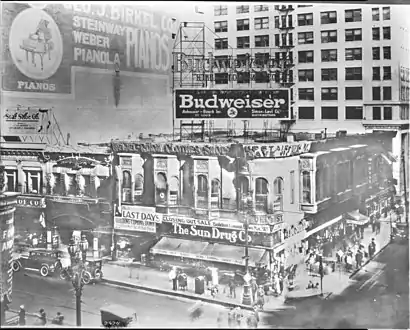 NE corner 5th/Broadway, early 1920s, before the Chester Williams Bldg. replaced the Victorian building
NE corner 5th/Broadway, early 1920s, before the Chester Williams Bldg. replaced the Victorian building Chester Williams Bldg., NE corner 5th/Broadway
Chester Williams Bldg., NE corner 5th/Broadway Detail, Chester Williams Bldg.
Detail, Chester Williams Bldg.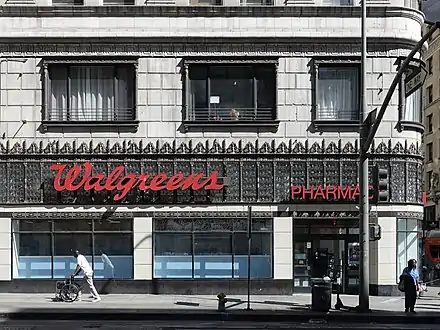 Chester Williams Bldg., Broadway side
Chester Williams Bldg., Broadway side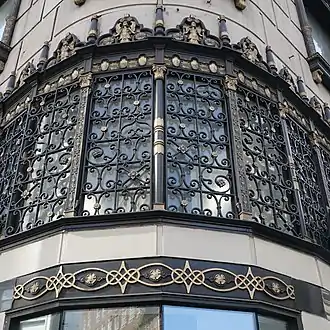 Ironwork, Chester Williams Bldg.
Ironwork, Chester Williams Bldg.
- Perla on Broadway, a modern 35-story condominium tower completed in 2022, 400 S. Broadway
- Site of first Thrifty Drug Store (razed), 412 S. Broadway
- Judson C. Rives Building (1907, Charles Ronald Aldrich, 10 stories), 424 S. Broadway, currently The Judson
- Bumiller Building (1906, Morgan & Walls, 6 stories), 430 S. Broadway, currently the Broadway Lofts
- Chester Williams Building (1926, Curlett & Beelman, 12 stories), 215 W. 5th St. (NE corner of Broadway), replaced a Victorian building with Sun Drug Co. and Weigel-Rixon Clothes Shops
Fifth to Sixth streets
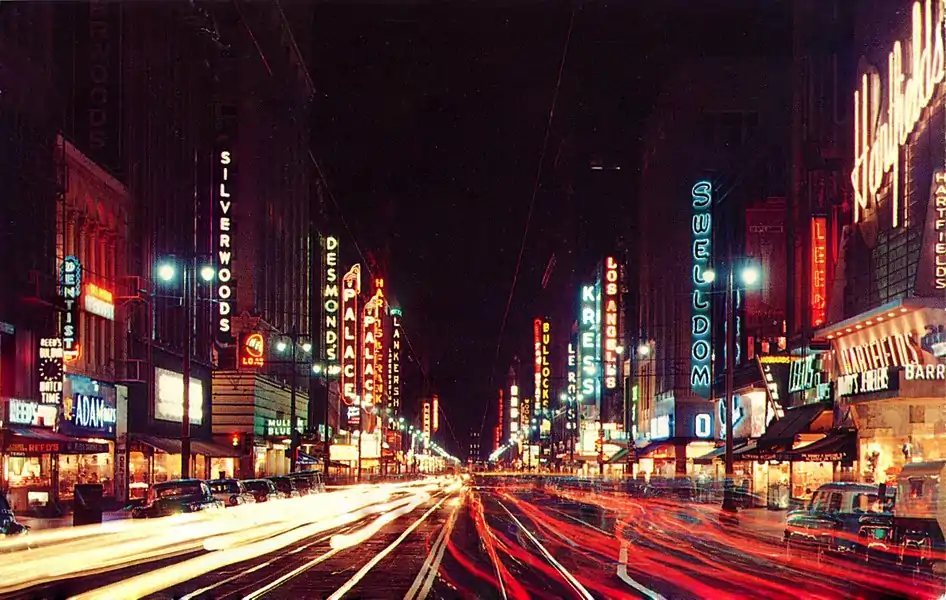 Broadway at night, 1950s, looking south from 5th Street. Visible are Hartfield's at #537, the Los Angeles Theatre, Silverwoods and Swelldom at the corner of 6th; the Palace Theatre, Harris & Frank and Desmond's in the 600 block; Bullock's and the Hotel Lankershim at the corner of 7th.
Broadway at night, 1950s, looking south from 5th Street. Visible are Hartfield's at #537, the Los Angeles Theatre, Silverwoods and Swelldom at the corner of 6th; the Palace Theatre, Harris & Frank and Desmond's in the 600 block; Bullock's and the Hotel Lankershim at the corner of 7th.
West side
.jpg.webp) West side of Broadway south from 5th St., Walker's department store, Los Angeles Railway "Yellow Cars", 1927 postcard
West side of Broadway south from 5th St., Walker's department store, Los Angeles Railway "Yellow Cars", 1927 postcard.jpg.webp) View north from 6th St. towards the 500 and 400 blocks of Broadway, west at left, east at right, c.1906. The new Parmelee-Dohrmann flagship (1906) at #436–444 Broadway is visible at center.
View north from 6th St. towards the 500 and 400 blocks of Broadway, west at left, east at right, c.1906. The new Parmelee-Dohrmann flagship (1906) at #436–444 Broadway is visible at center.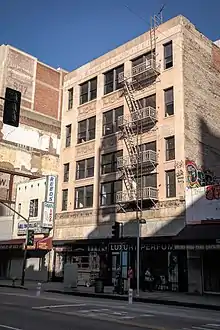 Schulte-United Building (1928)
Schulte-United Building (1928)_01.jpg.webp) F. & W. Grand Silver Store (Hartfield's) Building (1931)
F. & W. Grand Silver Store (Hartfield's) Building (1931)
- Fifth Street Store/Walker's department store bldg. (1927, architect Alexander Curlett), SW corner of 5th, 501 S. Broadway. The store was known by various names: 1905–1909: Steele, Faris, & Walker Co.; 1909–1925: The Fifth Street Store;[99][100] 1926–1946: Walker's;[101] 1946–1953 Milliron's;[101] 1953–1959: Ohrbach's-Downtown.[102]
- Schulte United Building (1928), 529 S. Broadway
- F. & W. Grand Silver Store Building (1931, Walker & Eisen, Art Deco), 537-541 S. Broadway. It has housed F. & W. Grand Silver five and dime from 1931–1934, a National Dollar store (1934), Richman Brothers (1950s), and a Hartfield's department store (1960s).[103]
East side
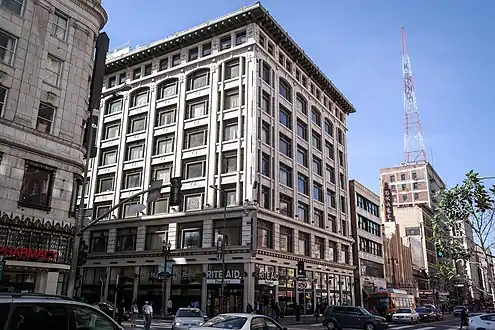 Title Guarantee Block, a.k.a. Jewelry Trades Building (1913, Morgan, Walls and Morgan, SE corner 5th/Broadway
Title Guarantee Block, a.k.a. Jewelry Trades Building (1913, Morgan, Walls and Morgan, SE corner 5th/Broadway%252C_510-512_S._Broadway_Los_Angeles.jpg.webp) Pettebone Building (1905, Robert Brown Young)
Pettebone Building (1905, Robert Brown Young)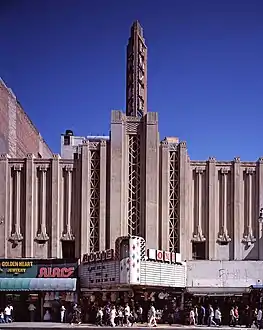 Roxie Theatre
Roxie Theatre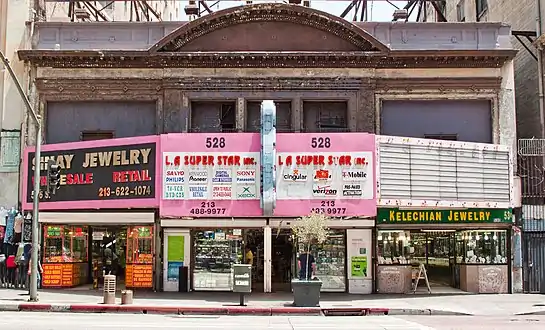 Cameo Theater (1910, Alfred Rosenheim)
Cameo Theater (1910, Alfred Rosenheim) Arcade Theater (1910, Morgan & Walls)
Arcade Theater (1910, Morgan & Walls)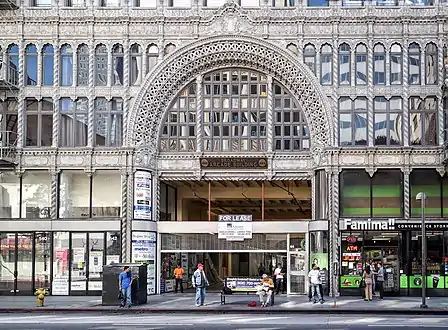 Spring Arcade
Spring Arcade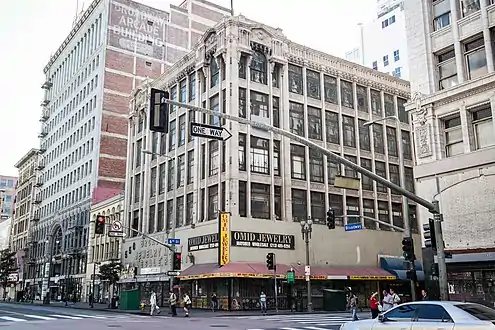 Silverwoods Building at #556-8, NE corner 6th/Broadway
Silverwoods Building at #556-8, NE corner 6th/Broadway%252C_Downtown_Los_Angeles_Detail.jpg.webp) Detail, Broadway entrance
Detail, Broadway entrance%252C_Downtown_Los_Angeles_Interior.jpg.webp) Interior
Interior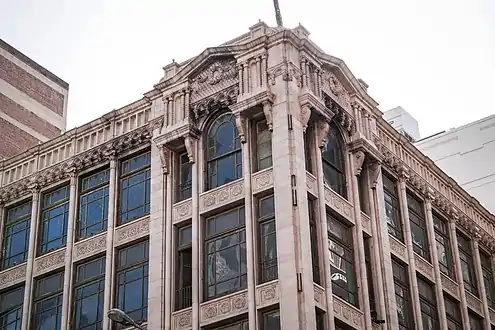 Detail, Silverwoods Building
Detail, Silverwoods Building
- The Title Guarantee Block (1913, Morgan, Walls and Morgan), 500 S. Broadway, SE corner of 5th, now called the Jewelry Trades Building
- Pettebone Building (opened 1905, architect Robert Brown Young), 510-512 S. Broadway
- Roxie Theatre (1931, orig. 1,600 seats), 518 S. Broadway – Movie palace – The Roxie was built in 1932—the last of the movie palaces built on Broadway. The Roxie had a seating capacity of 1,600 when it opened and was noted for its Art Deco or Zigzag Moderne style, including its stepped roofline, angular grillwork, chevron ornament, and terrazzo sunburst in the sidewalk. The theater's sleek Streamline Moderne ticket booth was removed when the theater was converted to retail use.[2]
- Cameo Theater – (1910, 900 seats), 528 S. Broadway — Nickelodeon – The Cameo opened in 1910 with a seating capacity of 775. Designed by Alfred Rosenheim in a Renaissance Revival style, the Cameo was originally known as Clune's Broadway. Until it closed in 1991, it was the oldest continuously operating movie theater in California.[2] The Cameo has been converted into a swap meet-type market.[104]
- Arcade Theater (1910, orig. 1,450 seats), 534 S. Broadway – English-music-hall-style theater – The Arcade opened in 1910 as a vaudeville house that was part of the Pantages vaudeville circuit. The Arcade was designed by Morgan & Walls in the Beaux Arts style with tripartite vertical division of the facade.[2] Theater has been closed since 1992. Currently used as retail space.
- Broadway Arcade (Spring Arcade Building), 540 S. Broadway
- Silverwoods Building (1920, Walker and Eisen), 556-8 S. Broadway, northeast corner of 6th Street. Housed Silverwoods, a specialty department store for apparel, flagship for a large regional chain. 5 stories.[94]
West side
Southwest corner of Sixth and Broadway
- H. Jevne Company Building, 603 S. Broadway, 1906-7, Parkinson & Bergstrom, still standing. H. Jevne & Co. was one of the city's most prominent grocer, and this new location complemented the one on Spring Street. Prior to 1906, the two-story frame Norton Block (of Major John H. Norton) stood on the site.[105]
600 block of Broadway, west side
.jpg.webp) W. side of Broadway between 6th and 7th c.1907–9. Bullock's at left, before it had expanded northward (to the right)
W. side of Broadway between 6th and 7th c.1907–9. Bullock's at left, before it had expanded northward (to the right)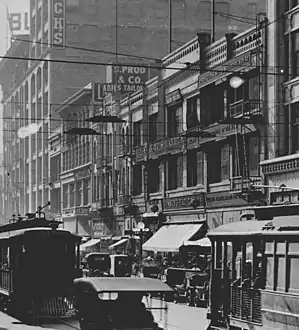 W. side of mid-600 block, Broadway, c.1915. Bullock's at left (NE corner of 7th). Central Dept. Store Bldg. (#609–619) at right
W. side of mid-600 block, Broadway, c.1915. Bullock's at left (NE corner of 7th). Central Dept. Store Bldg. (#609–619) at right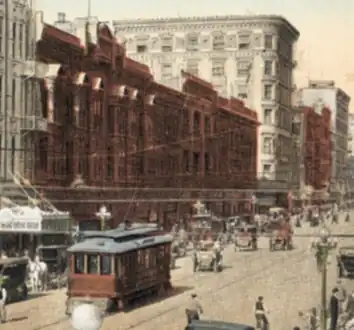 Crop of postcard of former Central Department Store and H. Jevne buildings, 1920s
Crop of postcard of former Central Department Store and H. Jevne buildings, 1920s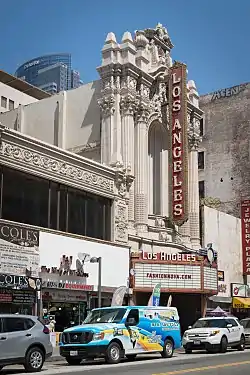 Contemporary view of the Los Angeles Theatre (#609–619)
Contemporary view of the Los Angeles Theatre (#609–619)
Next to what is now the Jevne building on the south at 609–619 S. Broadway were several buildings in succession:
- The Hotel Palms, a leading hotel of the city, renovated and repurposed in 1906-7 for use as the Central Department Store.[106]
- The Central Department Store, architect Samuel Tilden Norton, three floors and basement with a total of 85,000 sq ft (7,900 m2), opened on March 25, 1907,[107] but went bankrupt the next year.
- The New Paris Cloak and Suit Emporium at 609–11 advertised in 1915
- From 1921 or 1922 through 1927,[108] the prominent Myer Siegel clothing store was located in part of the building (#617–619).
- Los Angeles Theatre – (1931, 2,000 seats), 615 S. Broadway, Movie Palace – The Los Angeles opened in 1931 for the premiere of Charlie Chaplin's City Lights.[25] It had a seating capacity just short of 2,000. The theater was designed by S. Charles Lee and S. Tilden Norton in the French Baroque style, and was modeled on San Francisco's Fox Theater. The Los Angeles included the latest technological features when it opened, including an electric monitor of available seats, blue neon floor lights, a restaurant, a children's playroom, soundproof crying rooms, smoking room with built-in cigarette lighters, a walnut-paneled lounge with a secondary screen on which a periscope-like system of prisms relayed the film.[2] The ladies' powder room was lined with mirrors and vanities, and the toilet stalls were each done in a different kind of marble and each toilet bowl of a different pastel shade.[25] In 1988, the Los Angeles Times called it "a movie house for the gods, even in its present dusty state".[28] Columnist Jack Smith wrote that the Los Angeles Theater was "palatial beyond the dreams of a prince" with a lobby that suggested "nothing less than the glory of Versailles.".[25] Aerosmith's video for "Jaded" was filmed throughout the theater. It is owned by the Broadway Theatre Group, and continues to be used as a performing arts venue.[109] Current capacity: 1,931.
- former S. H. Kress five and dime, 621-3-5 S. Broadway
- St. Vincent's Jewelry Mart, formerly Bullock's dept. store, NW corner of Seventh and Broadway
East side
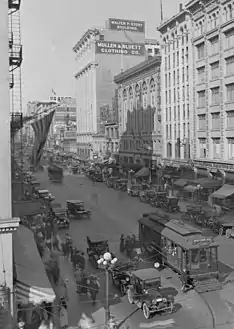 1923, view north from 7th St. to east side of 600 block, S. Broadway. Note Mullen & Bluett store.
1923, view north from 7th St. to east side of 600 block, S. Broadway. Note Mullen & Bluett store. 600 block, east side, with Palace Theatre
600 block, east side, with Palace Theatre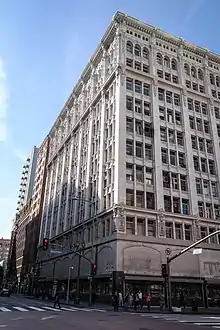 Walter P. Story Building (1909), SE corner of 6th, once home to Mullen & Bluett
Walter P. Story Building (1909), SE corner of 6th, once home to Mullen & Bluett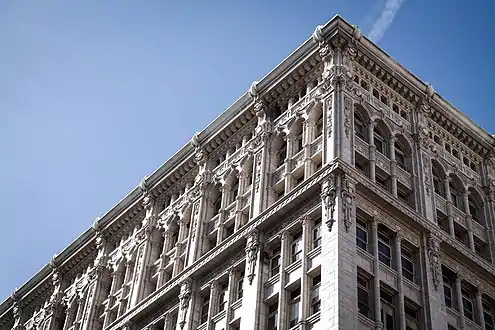 Detail, Walter P. Story Building
Detail, Walter P. Story Building Desmond's building in 2014
Desmond's building in 2014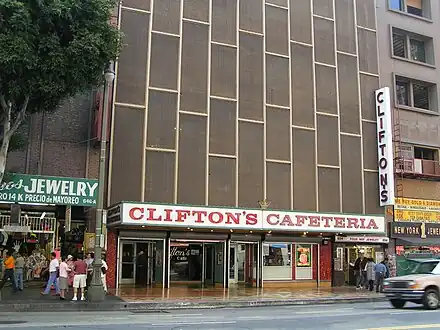 Clifton's Cafeteria in 2005, before its mid-century fronting was removed
Clifton's Cafeteria in 2005, before its mid-century fronting was removed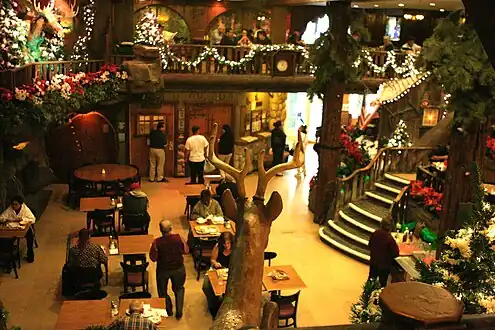 Interior of Clifton's Cafeteria
Interior of Clifton's Cafeteria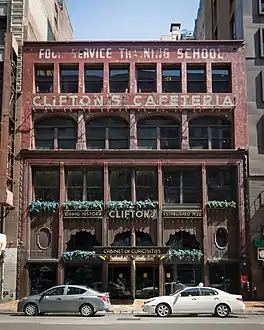
.jpg.webp) Palace Theater
Palace Theater
- Walter P. Story Building (1909, Morgan, Walls and Clements, Beaux-Arts) 600-2-4-6-8-10 S. Broadway, SE corner of Sixth and Broadway. Former location of the Mullen & Bluett clothing store.
- Desmond's dept. store bldg. (1924, Albert C. Martin, Sr., Beaux-arts and "Spanish", 6 stories, 85,000-square-foot (7,900-square-metre)), 616 S. Broadway. Desmond's opened its final flagship store here in 1924 and closed it in 1972.[110] In 2018 the building was renovated as office space, a restaurant and a rooftop bar.[111]
- Schaber's Cafeteria Building (1928), 620 S. Broadway, currently a Jordan Brand flagship store
- Palace Theatre (1911, G. Albert Lansburgh, Italian Renaissance Revival architecture, 2,200 seats originally, 1,068 seats today), 630 S. Broadway,– vaudeville theater and movie palace – The Palace opened in 1911 with a seating capacity of 2,200. It was an Orpheum Circuit (chain) vaudeville theater from 1911 to 1926 and is the oldest remaining Orpheum theater in the United States. The structure was based on a Florentine early Renaissance palazzo. The brick facade includes multi-colored terra-cotta swags and four panels depicting the muses of vaudeville sculpted by Domingo Mora.[2] It is also owned by the Broadway Theatre Group.[109]
- Joseph E. Carr Building (1908-9, Robert Brown Young, architect)[112] 644–646 S. Broadway. Site of Harris & Frank clothing store, its second downtown location, which operated from 1947–1980.[113]
- Clifton's Cafeteria, 648 S. Broadway
Seventh to Eighth streets
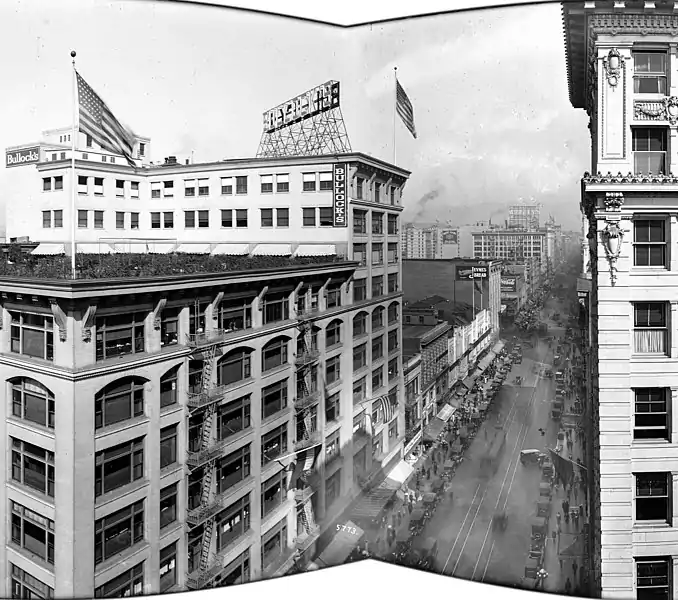
 Broadway south from 7th St. towards Hamburger's, 1917
Broadway south from 7th St. towards Hamburger's, 1917
West side
.jpg.webp)
- State Theatre (1921, 2,450 seats), 703 S. Broadway, – Vaudeville theater and movie palace – The State opened in 1921 with a seating capacity of 2,450.[114] The theater offered both film and vaudeville when it opened. Judy Garland performed at the theater as part of the Gumm Sisters in 1929. Designed by Charles Weeks and William Day, the 12-story Loew's State is said to be the largest brick-clad structure in Los Angeles.[114] The theater is also noted for the seated Buddha/Billiken figure, as a good luck charm, located in a niche above the proscenium arch.[2] The exterior has an elaborate "silver platter" chased ornamentation above the ground story.[115] In 1998, Metropolitan Theaters stopped showing movies at the State and leased the space to the Universal Church.[30] As of 2015 the State is owned by the Broadway Theatre Group and is leased by the Cathedral of Faith for use as a church.[116]
- F.W. Woolworth Building (1920), 719 S. Broadway, currently houses Ross Dress for Less

- Isaac Bros. Building, home of Reich and Lièvre “cloak and suit” emporium (women's apparel), 1917-ca. 1927, 739-745 Broadway
- Merritt Building (1915), 761 S. Broadway, (NW corner of 8th)
East side
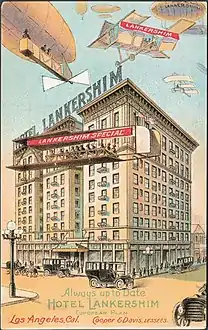 Hotel Lankershim (demolished)
Hotel Lankershim (demolished)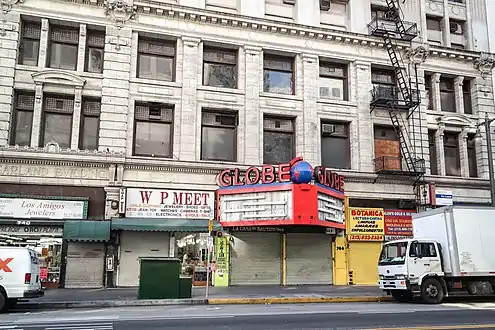 Globe Theater
Globe Theater.jpg.webp) Panoramic view from the Hotel Lankershim, showing 7th Street, Broadway, and Spring Street, ca.1905-1907
Panoramic view from the Hotel Lankershim, showing 7th Street, Broadway, and Spring Street, ca.1905-1907
- Site of Hotel Lankershim (1905, demolished), 700 S. Broadway (SE corner 7th St.)
Globe Theatre (1913, 1,900 seats) – Legitimate theater – Located at 744 S. Broadway, the Globe opened in 1913 as the Morosco Theatre, with a seating capacity of 782. Built for impresario Oliver Morosco and designed by the architectural firm of Morgan, Walls & Morgan, it was used for full-scale live dramatic theater. It was converted into a movie theater during the Great Depression and later served as a Spanish-language movie theater. The building was converted into a swap meet in 1987.[2] As of June 2014, construction to restore it to use as an entertainment venue is ongoing.[117] The restored marquee was relit June 24, 2014.[118] The Globe is now a multipurpose space for music, theatrical events and films. Current capacity: 2,000.
West side
_on_the_corner_of_Eighth_Street_and_Broadway%252C_Los_Angeles%252C_ca.1912_(CHS-5541).jpg.webp) May Co. Building, 1912
May Co. Building, 1912 Eastern Columbia Building: the "Jewel of Downtown"
Eastern Columbia Building: the "Jewel of Downtown"
- May Co. Bldg. (former dept. store), 829 S. Broadway
- Eastern Columbia Building, 849 S. Broadway
East side
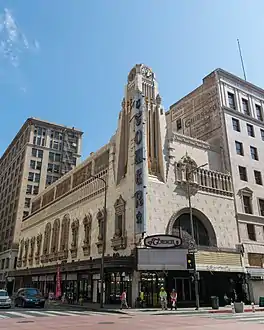 Tower Theatre at #802, SE corner 8th/Broadway
Tower Theatre at #802, SE corner 8th/Broadway.JPG.webp) Rialto Theater at #812
Rialto Theater at #812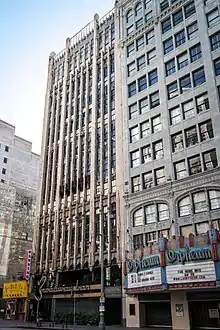 Platt Building at #830
Platt Building at #830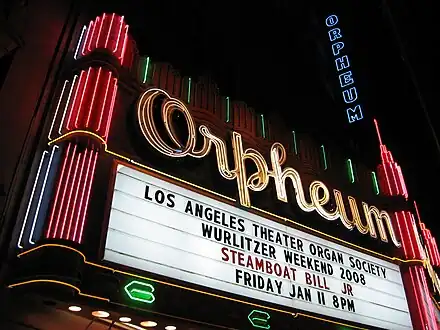 Orpheum Theatre at #842
Orpheum Theatre at #842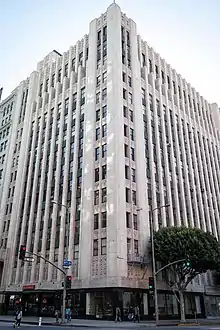 Ninth and Broadway Building, #850, NE corner 9th/Broadway
Ninth and Broadway Building, #850, NE corner 9th/Broadway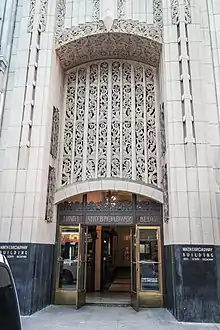 Ninth and Broadway Building, detail
Ninth and Broadway Building, detail
- Tower Theatre (1927, 900 seats), 802 S. Broadway. The Tower opened in 1927 with a seating capacity of 1,000.[119] It was the first of more than 70 theaters designed by S. Charles Lee, who described the Tower as a "modified French Renaissance" design. It was the first movie theater in Downtown Los Angeles equipped to accommodate talking pictures.[2] In June 2021, after extensive renovation, it reopened as an Apple Store.[120][109]
- Allied Arts Building (1922), 808 S. Broadway, bought by Singer Sewing Machine Company in 1939
- Rialto Theatre (1917), 812 S. Broadway, the Rialto opened as Quinn's Rialto, a nickelodeon, in 1917. It was purchased by Sid Grauman in 1919, the year after he opened the Million Dollar Theater. Today the theater is home to an Urban Outfitters store.[121][122][123]
- Wurlitzer Building (1923, Walker and Eisen), 818 S. Broadway
- Platt Building (1927, Walker and Eisen, Gothic Revival architecture), 830 S. Broadway, originally the headquarters of the Platt Music Corporation, and is now one of several Anjac Fashion's office buildings and home of The Broadway Bar.[124]
- Orpheum Theatre (1926, G. Albert Lansburgh, 1,976 seats), 842 S. Broadway. The Orpheum opened in 1926 as the fourth Los Angeles home for the Orpheum vaudeville circuit. Architect G. Albert Lansburgh designed the François Premier style interior. The Orpheum has hosted performances by Jack Benny, Eddie Cantor, Sophie Tucker, Will Rogers, Count Basie, Duke Ellington, the Marx Brothers, and Lena Horne.[2] In the 1990s, Tom Hanks used the Orpheum as a substitute for the Orpheum in Pittsburgh for his film That Thing You Do.[104] The Orpheum has also been featured in the Guns N' Roses video, "November Rain," and in the Sean Penn-produced video for Jewel's "You Were Meant for Me".[104] In 2006, the film Dreamgirls was shot at the Orpheum.[24] The television series So You Think You Can Dance and American Idol have used the Orpheum for Los Angeles auditions, and Idol has televised its early elimination rounds from the theater.
- Ninth and Broadway Building (1930, architect Claud Beelman), 850 S. Broadway[125]
West side
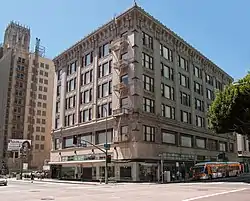
- Blackstone's Department Store building, 901 S. Broadway. Designed by John and Donald Parkinson in 1916, with 1939 a 1st floor facade remodeling by Morgan, Walls & Clements.
- Ace Hotel Los Angeles/United Artists Theatre (1927),[21] 921/933 S. Broadway, see below
United Artists Theater
- United Artists Theater (now The Theatre at Ace Hotel) – Movie palace – Located at 933 S. Broadway, the United Artists opened in 1927 with a seating capacity of 2,214. It was the showcase for movies from the United Artists group created in 1919 by Charlie Chaplin, Mary Pickford, Douglas Fairbanks and D.W. Griffith. The theater was designed by C. Howard Crane, with Walker & Eisen, in a Gothic style inspired by a church in Segovia, Spain. The columns feature terra cotta capitals carved with film and theater themed grotesques. The interior includes a series of frescoes and murals by the firm of Anthony Heinsbergen.[2] In 1990, the United Artists Theater was restored by Gene Scott's L.A. University Church; Scott called on his television flock to come to Los Angeles to help with the restoration.[126] Scott's famous "Jesus Saves" sign was placed on the back side of the building to avoid interfering with the original facade. In 2013 the upper floors of the building were renovated into a boutique hotel, the Ace Los Angeles; the auditorium has been returned to use as a concert venue and theater.
West side
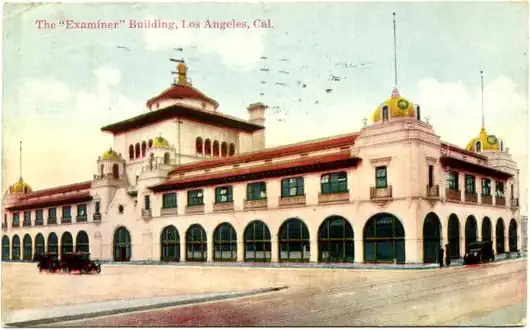 Los Angeles Examiner Bldg., old postcard
Los Angeles Examiner Bldg., old postcard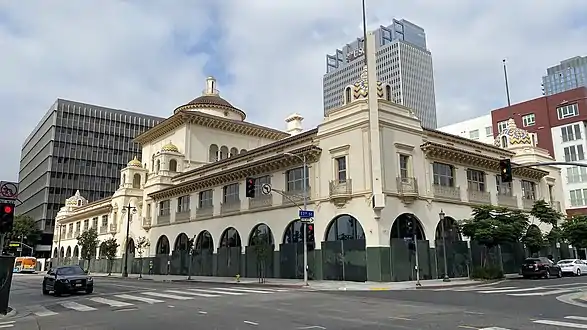 Herald Examiner Building, September 2020
Herald Examiner Building, September 2020
- Los Angeles Examiner building, SW corner 11th
- Athens Park, 124th to El Segundo Blvd.
- Site of the Globe Department Store, 51st and Broadway[127]
East side
- The Hoxton hotel, 1060 S. Broadway, in the Los Angeles Railway Building (1925, office building, Noerenberg & Johnson, Beaux-Arts architecture)[128]
- Proper Hotel, 1100 S. Broadway, (1926, Curlett & Beelman, California Renaissance Revival architecture). The building originally housed the Commercial Club of Southern California, then the Cabrillo Hotel in the early 1940s, the Case Hotel from the late 1940s to the mid-1960s, and a YMCA from 1965 to 2004.[129]
Other surviving theaters adjacent to Broadway
- Warner Bros. Downtown Theatre – Vaudeville theater and movie palace – Located at 401 W. 7th St (northwest corner of South Hill and West 7th St). Opening on August 17, 1920, it was originally called the Pantages Theatre, but was renamed Warner Bros. Downtown Theatre in 1930 after the Hollywood Pantages Theatre was opened.[130][131] The exterior has an imposing domed corner tower, flanked by twin facades on 7th and Hill.[132] Later in the 1960s, it was known as the Warrens Theatre.[131] It currently houses a jewelry store.
- Olympic Theatre – Movie palace – Located at 313 W. 8th St, half a block from S. Broadway, it originally opened in 1927 as Bard's 8th Street Theatre, converted from a restaurant. For a time, it had a second entrance on Broadway. After a period as a chandelier store, COS, a higher-end brand of H&M, began remodeling the store in 2016.[133][123]
- Mayan Theater – Vaudeville theater and movie palace – Located at 1014 South Hill Street. Opened in August 1927 and now designated a Historic Cultural Monument, the Mayan is currently used as a nightclub. Current capacity: 1,491
- Belasco Theatre – Legitimate theater – Located at 1050 South Hill Street, adjacent to the Mayan. Built by the Belasco brothers, and designed by Morgan, Walls and Clements. It served as a church from 1950 to 1987, renovations were completed in 2011 to modernize the sound and lighting systems.[134] Currently hosts services for the Los Angeles campus of Hillsong Church. Current capacity: 1,601.
Street grid
South of Third Street
Landmarks are shown on the following street grid of the Historic Core of Downtown Los Angeles.
Abbreviations and notes
- Abbreviations: DS=Department Store. Res.=residential building
- Architectural styles: AD=Art Deco, BA=Beaux-Arts, BR=Baroque Revival, CR=Classical Revival, IRR=Italian Renaissance Revival, It=Italianate, Rom=Romanesque, RR=Renaissance Revival
- Architects: C&B=Curlett & Beelman, JP=John Parkison, P&B=Parkinson & Bergstrom, RBY=Robert Brown Young
- Italics indicate the building's current name or main tenant.
- Non-italics indicate a historic name or tenant of an existing building.
- *An asterisk indicates a demolished building.
| H I L L S T. |
Irvine Byrne Block/ now Pan American Lofts (1895) |
B R O A D W A Y |
Douglas Bldg. (1899) | S P R I N G S T R E E T |
Stimson Bldg. (1893–1963) | M A I N S T R E E T |
L O S A N G E L E S S T R E E T | ||||||
| THIRD ST. | THIRD ST. | THIRD ST. | THIRD ST. | THIRD ST. | |||||||||
| —Million Dollar Theatre | —Bradbury Bldg. (1893) —Blackstone's DS (1907–1917) |
Ronald Reagan State Bldg. (1990) | Toy District | ||||||||||
| Angels Flight | Homer Laughlin Building (1898): Now Grand Central Market. formerly Coulter's, Ville de Paris |
Broadway Spring Center parking structure (1990) | Round House | ||||||||||
| Jacoby Bros. DS* (#331–5; 1900–1935) —Grant Bldg. (1898) |
Trustee Building (#340, 1905 PB) —O. T. Johnson Block (#350, 1895 It RBY) —O. T. Johnson Bldg. (#356, 1902 JB Rom) |
parking lot | Hellman Bldg. (1902) | ||||||||||
| FOURTH ST. | FOURTH ST. | FOURTH ST. | FOURTH ST. | FOURTH ST. | |||||||||
| The Broadway DS/ Junípero Serra State Office Bldg. #2 |
vacant | parking lot | Continental Bldg. (1902) | San Fernando Bldg. (1906 IRR) | Toy District | ||||||||
| Subway Terminal Bldg./ Now "Metro 417" |
—Hotel Clark —Occidental Hotel —Boos Bros. Cafeteria —St. Clarenden Hotel |
Judson C. Rive Bldg. (1907) | 419 S. Spring 435 S. Spring |
Stowell/El Dorado Hotel/ El Dorado Lofts (1913) Dog Park |
|||||||||
| Title Guarantee Bldg. (1930) | Metropolitan Bldg. (1913)/Newberry's 5&10¢/Now Fallas Paredes DS and lofts | Chester Williams Bldg. (1926) | Crocker Bank/ Spring Arts Tower (1915) |
Title Insurance and Trust Company Building/ Trust Bldg. (1928) |
Rowan Bldg (1912) | King Edward Hotel (1906 P&B) | |||||||
| FIFTH ST. | FIFTH ST. | FIFTH ST. | FIFTH ST. | FIFTH ST. | |||||||||
| Pershing Square | Pershing Square station (Metro Rail) | Fifth Street Store DS | Roxie Theatre Cameo Theater Arcade Theatre (now retail) |
Hotel Alexandria (1906) | Security Trust and Savings Bank/ Security Bldg. Lofts (1907) |
Hotel Rosslyn Annex | Pershing Hotel/ Pershing Apts. (1889) |
Baltimore Hotel (1910) | |||||
| Spring Arcade | Los Angeles Theater Center (1916) | Parking Structure (#545) | Topaz Apts. | ||||||||||
| Paramount Theatre/ International Jewelry Center |
Swelldom DS | Silverwoods DS/ Broadway Jewelry Mart |
Pacific Southwest Bank (1910) | Santa Fe Bldg. (1906) | |||||||||
| SIXTH ST. | SIXTH ST. | SIXTH ST. | SIXTH ST. | SIXTH ST. | |||||||||
| —Consolidated Reatly Bldg./ California Jewelry Mart (1908/1935) —Sun Realty Bldg./ Los Angeles Jewelry Center (1931) —Harris & Frank Bldg./ Wholesale Jewelry Exchange (1925) |
—Western Jewelry Mart —William Fox Bldg. (Fox Jewelry Plaza) (1932) |
Los Angeles Theatre | —Mullen & Bluett DS/ Walter P. Story Bldg. —Desmond's Bldg. —Palace Theatre —J. E. Carr Bldg. —Harris & Frank 1947-1980 |
Hotel Hayward E. F. Hutton (1931) California Canadian Bank (1923) Barclays Bank (1919) |
United California Bank Stock Exchange Mortgage Guaranty Building (1913) Banks & Huntley Bldg. (1930) |
Pacific Electric Building | |||||||
| Warner Bros. (a.k.a. Pantages, Warren) Theatre (1920) Now Jewelry Theater Center |
Bullock's DS/ St. Vincent Jewelry Center |
Bank of Italy/ Bank of America/ SB Lofts (1924) |
Bartlett Bldg. (1911) | ||||||||||
| SEVENTH ST. | SEVENTH ST. | SEVENTH ST. | SEVENTH ST. | SEVENTH ST. | |||||||||
| Foreman & Clark DS/ Foreman & Clark Bldg. (1928, Curlett & Beelman, Art Deco and Neo-Gothic) |
State Theatre | —Hotel Lankershim —Globe Theatre |
Dearden's DS | ||||||||||
| Garfield Bldg. (1930) | Union Bank & Trust Company Bldg. Union Lofts (1922) |
Griffin on Spring Apts. (2018) | Great Republic Lofts (1923) | ||||||||||
| EIGHTH ST. | EIGHTH ST. | EIGHTH ST. | EIGHTH ST. | EIGHTH ST. | |||||||||
| RKO Hillstreet Theatre (1922-1963)/ 820 Olive/ 825 South Hill (res.) |
Hamburger's DS (1908-1923)/ May Company DS (1923-1986)/ May Company Building |
Tower Theatre (1927 BR) Rialto Theatre (1917 AD/CR) Orpheum Theatre (1926 BA) |
Lane Mortgage Bldg. (1923) | National City Tower (1924)[135] | —California Theatre (1918–1990 BA) |
Gray Bldg. (#824) | |||||||
| Coast Fed. Savings Bldg. (1926) | Parking lot Alexan tower (planned) |
City Club Bldg. (1925)[137] | Harris Newmark Bldg. (1926 RR C&B) | Cooper Bldg. (1926 C&B) | |||||||||
| NINTH ST. | NINTH ST. | NINTH ST. | NINTH ST. | ||||||||||
| small retail | May Co. Garage Bldg.(1926) | United Artists Theatre/ Ace Hotel |
Gerry Building (1947 SM) | ||||||||||
| South Park by Windsor Apts. | Broadway Palace Apts. (2017) | ||||||||||||
| OLYMPIC BL. | (formerly TENTH ST.) | OLYMPIC BL. | (formerly TENTH ST.) | ||||||||||
| Mayan Theater Belasco Theatre |
Broadway Palace Apts. (2017) | ||||||||||||
| Western Pacific Bldg. (1925) | |||||||||||||
| White Log Coffee Shop[138] | Los Angeles Railway HQ/ Hoxton Hotel (1925) |
||||||||||||
| ELEVENTH ST. | ELEVENTH ST. | ELEVENTH ST. | ELEVENTH ST. | ||||||||||
| Proposed 43-story Sky Trees res. tower[139] | Herald-Examiner Bldg. (1914) | Commercial Club/ Proper Hotel (1926) |
Harris Building (1923 BA) | ||||||||||
Table of former department stores on Broadway and 7th streets
| Opened | Left | Moved or closed? | Store | Floor area (gross) | Location | Architects | Current use |
|---|---|---|---|---|---|---|---|
| SPRING ST. BETWEEN TEMPLE AND SECOND | |||||||
| 1884 | 1898 | Moved to B'way | Coulter's | Hollenbeck Block, SW corner 2nd & Spring | Historic Broadway station | ||
| 1888 | 1908 | Moved to 8th/B'way | Hamburger's | Phillips Block, Franklin & Spring | Burgess J. Reeve | Site of City Hall | |
| 1889 | 1910 | Moved to B'way | Mullen & Bluett | 101–5 N. Spring | Empty lot | ||
| 1891 | 1900 | Moved to 3rd/B'way | Jacoby Bros. | 128–134(–138) N. Spring at Court | Site of City Hall | ||
| 1895 | ? | The Hub | Bullard Block, Spring at Court | Morgan & Walls | Site of City Hall | ||
| BROADWAY north of 4th St. | |||||||
| 1893 | 1898 | Moved to 317 B’way | Ville de Paris[140] (A. Fusenot Co.) |
Potomac Block, 221-3 S. Broadway | Block, Curlett & Eisen | added to Coulter's late 1907, demolished 1958, now a parking lot | |
| 1895 | 1915 | Moved to 7th St. | Boston Dry Goods (J.W. Robinson Co.) |
237–241 S. Broadway | Theodore Eisen and Sumner Hunt (architects of the Bradbury Building) |
Parking lot | |
| 1898 | 1905 | Moved to 200 block of B'way | Coulter's (1898–1905) | 317–325 S. Broadway through to 314–322 Hill Street[141] Homer Laughlin Building |
John B. Parkinson | became Ville de Paris Now Grand Central Market | |
| 1899[142] | 1935-6 | Moved to 605 B'way[143][144] | Jacoby Bros. | 60,000 sq ft (5,600 m2) | 331-333-335 S. Broadway | John B. Parkinson[145] | Was "Boston Store" in late 1930s.[146] Currently independent retail. 2 of 4 floors were removed. |
| 1899 | ? | Moved to 455 B'way then 617 B'way | I. Magnin/ Myer Siegel |
Irvine Byrne Block, 251 S. Broadway[147] |
Sumner Hunt | Wedding chapel | |
| 1905 | 1917 | Moved to 7th St. | Coulter's | 157,000 sq ft (14,600 m2)[148] | Potomac Block: 225-7-9 S. Broadway through to 224-6-8 S. Hill St. Late 1907 added 219-221-223 S. Broadway to store. | Block, Curlett & Eisen | demolished, site of parking lot |
| 1905 | 1917 | Moved to 7th St. | Ville de Paris | 96,000 sq ft (8,900 m2) | 317–325 S. Broadway through to 314–322 Hill Street[141] Homer Laughlin Building |
John B. Parkinson | Grand Central Market |
| 1905 | 1917 | Moved to 7th St. | J. J. Haggarty Co. “New York Store’ | 337–9 S. Broadway | Independent retail. Only 2 stories remain. | ||
| 1909 | ? | ? | J. M. Hale (Hale’s) | 341-343-345 S. Broadway[149] | retail, top floors were removed | ||
| BROADWAY south of 4th St. | |||||||
| 1896 | 1973 | Moved to B'way Plaza | The Broadway Dept. Store[150] | 1924, 577,000 sq ft (53,600 m2)[151] | SW corner 4th & Broadway, later through to Hill | Junipero Serra State Office Building | |
| 1904 | ? | ? | Silverwoods | 1920: 115,420 sq ft (10,723 m2)[152] | 556 S. Broadway (NE corner of 6th) | Broadway Jewelry Mart | |
| 1905 | ? | Closed | Fifth Street Store (Steele, Faris, & Walker Co.) Later called Walker's |
1917: 278,640 sq ft (25,887 m2)[153] | SW corner 5th & Broadway | Replaced existing store with new building in 1917[153] Building later housed Ohrbach's | |
| 1906 | 1986 | Moved to FIGat7th | Hamburger's After 1925: May Company |
1906: 482,475 sq ft (44,823.4 m2)[154][155] 1930, >1,000,000 sq ft (93,000 m2)[156] |
SW corner 8th & Broadway by 1930, entire block 8th/9th/Broadway/Hill |
Under renovation to become tech campus | |
| 1907 | 1983 | Closed, opened 1986 at FIGat7th | Bullock's | 1907: 350,000 sq ft (33,000 m2) 1934: 806,000 sq ft (74,900 m2)[157] |
NW corner 7th & Broadway by 1934, most of the block 6th/7th/Broadway/Hill |
Parkinson & Bergstrom | St. Vincents Jewelry Mart |
| 1907 | 1908 | Central Department Store[158] | 85,000 sq ft (7,900 m2), [159] | 609–619 S. Broadway | Samuel Tilden Norton | Demolished, now site of Los Angeles Theatre | |
| 1910 | 1960s | Mullen & Bluett | 610 S. Broadway (Walter P. Story Bldg.)[160] |
Morgan, Walls & Clements | Mixed-use | ||
| 1917 | Blackstone's | 118,800 sq ft (11,040 m2)[161] | 901 S. Broadway (SE corner 9th) | John Parkinson | Building became The Famous, now residential, retail | ||
| 1924 | 1972[162] | Abandoned Downtown L.A. | Desmond's | 85,000 sq ft (7,900 m2)[111] | 616 S. Broadway | A. C. Martin[163] | Renovated 2019 as office space, a restaurant and a rooftop bar.[111] |
| 1930 | 1957[164] | Eastern Columbia | 1930: 275,650 sq ft (25,609 m2)[165] (expanded through to Hill St. in 1950)[166] | 849 S. Broadway through to Hill | Claud Beelman | luxury condos | |
| 1936[144] | 1938[167] | Company liquidated | Jacoby Bros. | 605 S. Broadway[144] | became a branch of Zukor's (1940),[168] now mixed-use | ||
| 1947 | 1980[169] | Abandoned Downtown L.A. | Harris & Frank 2nd downtown location | 644 S. Broadway (Joseph E. Carr Bldg.) |
Robert Brown Young[170] | ||
| SEVENTH STREET | |||||||
| 1915 | 1993 | Abandoned Downtown L.A. | J. W. Robinson's | 1915: 400,000 sq ft (37,000 m2)[171] 1923: 623,700 sq ft (57,940 m2)[172] |
7th, Hope & Grand | Noonan & Richards (1915), Edgar Mayberry/Allison & Allison (1934 remodel) | Mixed-use |
| 1917 | 1933 | B. H. Dyas liquidated | Ville de Paris, from 1919 B. H. Dyas | 420 W. 7th (SE corner Olive) | Dodd and Richards | L.A. Jewelry Mart | |
| 1917 | 1938 | Moved to Miracle Mile | Coulter's | 500 W. 7th (SW corner Olive) | Dodd and Richards | Mixed-use | |
| 1917 | 1963[173] | Abandoned Downtown L.A. | Haggarty's | Brockman Building, 7th & Grand[174][175][86][176] |
George D. Barnett (of Barnett, Haynes & Barnett) |
Apartments | |
| 1926 | 1984[177] | Barker Bros. | Abandoned Downtown L.A. | 23 acres (1,000,000 sq ft; 93,000 m2)[178] | 818 W. 7th (Flower to Figueroa) | Curlett and Beelman | Offices |
| 1973 | open* | The Broadway | 250,000 sq ft (23,000 m2)[179] | Broadway Plaza 750 W. 7th (Hope to Flower) | Charles Luckman | Macy's | |
| 1986 | 1996 | Became duplicate Macy's, closed | Bullock's | Seventh Market Place now FIGat7th | Jon Jerde[180] | Gold's Gym (level M1), Target (M2), Zara (M3) | |
| 1986 | 2009a | Became duplicate Macy's, closed | May Company | Nordstrom Rack (level M1), Target (M2), H&M (M3) | |||
aas Macy's
Public transportation
The Los Angeles Metro Rail's Historic Broadway station is an underground light rail station near the intersection of 2nd and Broadway,[181][182] which is served by the E Line east to East Los Angeles and west to Santa Monica, and on the A Line northeast to Union Station, Pasadena, and Azusa and south to Long Beach.[183]
Metro J Line bus rapid transit (BRT) has 5 stations adjacent to Broadway in South Los Angeles: 37th Street/USC, Slauson, Manchester/I-110, Harbor Freeway, and Rosecrans. These stations are along the Harbor Transitway, a dedicated busway between Downtown L.A. (Adams Blvd.) and the Harbor Gateway, near Carson, in the median of the Harbor Freeway (I-110), just west of Broadway. J Line BRT runs as far south as San Pedro and as far northeast as El Monte.
Metro Local bus line 45 serves most of the length of Broadway, between Lincoln Heights through Downtown to the Harbor Freeway Station. Local routes 4, 30, and 40 serve portions of Broadway downtown.
See also
- Broadway Theater District (Los Angeles)
- List of Los Angeles Historic-Cultural Monuments in Downtown Los Angeles
- List of Registered Historic Places in Los Angeles
- Theater districts in the United States
References
- "National Register Information System". National Register of Historic Places. National Park Service. April 15, 2008.
- Sandra A.B. Levis. "Broadway Historic Theater District: A walking tour sponsored by the Los Angeles Conservancy" (PDF). Los Angeles Conservancy.
- "City In Brief". Los Angeles Times. September 6, 1889. p. 8. Alternate Link via ProQuest.
- "Other 3 -- No Title". Los Angeles Times. February 18, 1890. p. 4. Alternate Link via ProQuest.
- "Sou', Sou'west". Los Angeles Times. February 26, 1891. p. 4. Alternate Link via ProQuest.
- "Realtors Want New Boulevard: Ask Supervisors for Route Connecting Moneta Avenue With Harbor". Los Angeles Times. December 10, 1922. p. V9. Alternate Link via ProQuest.
- "A Literary Fog". Los Angeles Times. November 30, 1909. p. II4. Alternate Link via ProQuest.
- "The Lancer". Los Angeles Times. January 22, 1911. p. II5. Alternate Link via ProQuest.
- "Downey And Buena Vista Will Be North Broadway". Los Angeles Herald. Vol. 35, no. 353. September 19, 1908 – via California Digital Newspaper Collection.
- "Object to Changing Name". Los Angeles Herald. Vol. 32, no. 105. January 14, 1905 – via California Digital Newspaper Collection.
- "Buena Vista Street Will Continue Name: Will Not Be Changed to North Broadway". Los Angeles Herald. Vol. 32, no. 238. May 27, 1905 – via California Digital Newspaper Collection.
- "Object to Merger Of Downey Avenue". Los Angeles Herald. Vol. 36, no. 24. October 25, 1908 – via California Digital Newspaper Collection.
- "East Side Residents, Prefer Downey Avenue". Los Angeles Herald. Vol. 37, no. 200. April 19, 1910 – via California Digital Newspaper Collection.
- "Majestic; Great Viaduct About Ready; Cars Run Over the Buena Vista Structure; Concrete Bridge Across Los Angeles River Weighs Nearly Forty Thousand Tons, Cost Two Hundred and Seventy-five Thousand Dollars—Without a Peer in West". Los Angeles Times. September 24, 1911. p. II1. Alternate Link via ProQuest.
- "The Boston Dry Goods Store". Los Angeles Times. January 1, 1895. p. 29. Retrieved May 3, 2019.
- "The New Boston Store:Los Angeles' Finest Commercial Structure Is Complete". Los Angeles Herald. October 4, 1895. p. 5.
- "Framework is now finished: Construction Started Late Last Fall: Additional Will Be Completed During July: Department Store Growth Is Consistent". Los Angeles Times. March 23, 1924. p. 91. Retrieved May 26, 2020.
- "Clipped From Los Angeles Herald". Los Angeles Herald. April 15, 1906. p. 20 – via newspapers.com.
- "11 Jan 1923, 27 - The Los Angeles Times at Newspapers.com". Newspapers.com.
- pcad.lib.washington.edu/building/9453/
- DiMassa, Cara & Bloomekatz, Ari B. (January 28, 2008). "L.A. plans Broadway face-lift". Los Angeles Times. pp. B1, B8.
- "Broadway Theater and Entertainment District Design Guide, City of Los Angeles Planning Department, 2009" (PDF). Archived from the original (PDF) on April 19, 2017. Retrieved May 20, 2019.
- Dan Turner (June 11, 2006). "Our So-Cal Life: Faded glory on Broadway". Los Angeles Times.
- Cara Mia DiMassa (February 17, 2006). "Movie Tradition Fading to Black; Seventy years after its neon heyday, downtown Los Angeles is struggling to keep its last cinematic venue afloat". Los Angeles Times.
- Jack Smith (September 30, 1986). "Los Angeles Theater: Flashback to yesteryear ... and a Latino renaissance on Broadway". Los Angeles Times.
- "D.O.A. (1949) - IMDb" – via www.imdb.com.
- "The Omega Man (1971) - IMDb" – via www.imdb.com.
- Dan Sullivan (August 21, 1988). "L.A.'s Grand Old Broadway Theaters". Los Angeles Times.
- Robert Levine (June 12, 1994). "Silent Screens: Encore for Carter, Old Movie District". Los Angeles Times.
- John Regardie (November 2, 1998). "State of Darkness: Another Movie Palace Quits Screening Films". Los Angeles Downtown News.
- Cara DiMassa (January 28, 2008). "L.A. plans Broadway face-lift". Los Angeles Times.
- "Bringing Back Broadway". City of Los Angeles.
- Hawthorne, Christopher (December 6, 2014). "'Latino Urbanism' influences a Los Angeles in flux". Los Angeles Times.
- "Must Reads: Downtown L.A.'s latest retail renaissance? Broadway's burgeoning 'Sneaker Row'". Los Angeles Times. December 8, 2018.
- Jose Huizar - Councilmember District 14, City of Los Angeles. "Councilmember Huizar's Bringing Back Broadway Initiative Welcomes Acne Retail" (PDF). Archived from the original (PDF) on September 23, 2015. Retrieved May 18, 2019.
- Fashionista. Inside Downtown Los Angeles's Retail Boom
- "Map of Temple Street Cable Railway, via Metro (Los Angeles County)".
- "Temple Street Cable Railway (1886)". www.erha.org.
- "New Buildings: A Splendid Showing for the Future Los Angeles". Los Angeles Times. May 13, 1888. p. 3.
- "Water and Power Associates".
- "Los Angeles County Central Heating and Refrigeration Plant". Calisphere.
- "Water and Power Associates". waterandpower.org.
- "Water and Power Associates". waterandpower.org. Retrieved May 22, 2021.
- "PCAD - Tajo Building, Downtown, Los Angeles, CA". pcad.lib.washington.edu.
- search for the location, Google Maps, retrieved October 20, 2020
- "Water and Power Associates".
- "BEgins New Era of Achievement: Chamber of Commerce Welcomes Public to Magnificent Home, with Brilliant Reception — Annual Reports Show Splendid Progress". The Los Angeles Times. February 13, 1904. p. 13. Retrieved November 10, 2020.
- "PCAD - Los Angeles Chamber of Commerce Building, Downtown, Los Angeles, CA". pcad.lib.washington.edu.
- "Junipero Serra State Office Building #1", Pacific Coast Architecture Database
- "New Los Angeles US Courthouse". www.gsa.gov.
- "Mason Theatre in Los Angeles, CA - Cinema Treasures". cinematreasures.org.
- "2nd Street and Broadway" Huntington Digital Library
- Marques Vickers, Reinventing Broadway, p.52
- "Water and Power Associates".
- "Broadway to the Front". Los Angeles Evening Express. August 7, 1891. p. 8.
- "Advertisement for City of Paris". Los Angeles Times. August 6, 1895. p. 10.
- "Merchants Trust Company Building, ca.1910". Calisphere.
- "Great Store for Coulter". Los Angeles Times. August 2, 1904. p. 13.
- Hill, 224-6-8 S. (November 2, 1906). "Coulter's location 1906 225–229 S. Broadway". The Los Angeles Times. p. 19.
- "Ad for Coulter's new store opening". Los Angeles Times. May 31, 1905.
- "Potomac Block :: Los Angeles Public Library Photo Collection". tessa.lapl.org.
- "Potomac Block. The Work of Building Up a Great City". Los Angeles Herald. July 18, 1890.
- "Potomac Block & Bicknell Block – Romanesque Revival Downtown – PocketSights". pocketsights.com.
- "Western Shoe Company – Western Department Store – 227 S Broadway". Los Angeles Evening Express. May 26, 1922. p. 14. Retrieved May 22, 2021.
- "The Boston Dry Goods Store". Los Angeles Times. January 1, 1895. p. 29. Retrieved May 3, 2019.
- "The New Boston Store:Los Angeles' Finest Commercial Structure Is Complete". Los Angeles Herald. October 4, 1895. p. 5.
- "31 Dec 1898, 4 – Los Angeles Times at Newspapers.com". Newspapers.com.
- "19 Jun 1904, 12 – Los Angeles Times at Newspapers.com". Newspapers.com.
- Sanborn Map of Los Angeles: 1894, vol. 1, plate 8, via Library of Congress.
- Sanborn Map of Los Angeles: 1906, vol. 2, plate 131, via Library of Congress.
- Sanborn Maps of Los Angeles: 1894, vol. 1, plate 8; 1906, vol. 2, plate 131.
- "Pig 'n Whistle opens 224 S. Broadway". The Los Angeles Times. December 10, 1908. p. 22 – via newspapers.com.
- "CityDig: This Was L.A.'s City Hall for 39 Years". Los Angeles Magazine. May 8, 2014. Retrieved May 16, 2019.
- Maese, Kathryn. "The Victor No Longer". Los Angeles Downtown News - The Voice of Downtown Los Angeles. Retrieved August 11, 2020.
- "I Magnin moves from Spring to Broadway 1". Los Angeles Times. December 31, 1898. p. 4 – via newspapers.com.
- Flynn, Kathleen Nye. "Mixing the Old With the New". Los Angeles Downtown News – The Voice of Downtown Los Angeles. Retrieved May 22, 2021.
- "Business Property Deal: Nearly Two Hundred Thousand Dollars for a Good Corner". March 22, 1899.
- "22 Sep 1989, 19 - The Los Angeles Times at Newspapers.com". Newspapers.com. Retrieved October 13, 2018.
- "Bradbury Building | Los Angeles Conservancy". www.laconservancy.org.
- "The Opening of North Broadway". Los Angeles Times. October 9, 1895. p. 6.
- "Jacoby Bros. ad". Los Angeles Times. November 28, 1899. Retrieved May 22, 2019.
- "Will Go Up Rapidly: Work on the Jacoby Building Was Begun Today: Most of the Material for the Big Business Structure Is Already on the Ground". Los Angeles Evening Post-Record. September 1, 1899. p. 1.
Architect John Parkinson
- "Boston Store Los Angeles 1939 - 331 S. Broadway (old Jacoby Bros.) and 4755 Whittier Blvd". The Los Angeles Times. November 6, 1939. p. 10 – via newspapers.com.
- "Water and Power Associates".
- "New Cloak and Suit House". Los Angeles Times. January 22, 1905.
- "New York Store's Life Dream Comes True: J. J. Haggarty Ready to Open New Emporium at Seventh and Grand Tomorrow". Los Angeles Evening Express. September 19, 1917.
- "Moving to Broadway: J. M. Hale Co. Go to Petticoat Lane". Los Angeles Evening Express. January 23, 1909. p. 4.
- "Los Angeles Herald 7 March 1921 — California Digital Newspaper Collection". cdnc.ucr.edu.
- "The Grant Block". Los Angeles Times. February 13, 1898.
- "To be enlarged". Los Angeles Times. May 4, 1902.
- "PCAD - Grant Building, Downtown, Los Angeles, CA". pcad.lib.washington.edu.
- "Los Angeles Herald 1 September 1908 — California Digital Newspaper Collection". cdnc.ucr.edu.
- "Brief History of the Consulate". Philippine Consulate General in Los Angeles. Department of Foreign Affairs. Retrieved October 18, 2021.
- "Application form for Broadway Theater and Commercial District, National Register of Historic Places".
- "318-320 S Broadway, Los Angeles, CA 90013 – Retail for Sale | LoopNet.com". LoopNet.
- "National Register of Historic Places Inventory -- Nomination Form". npgallery.nps.gov. Archived from the original on September 2, 2019. Retrieved May 22, 2021.
- "Mistitled: 365 S. Broadway (see detailed description at source)". USC Library.
- "PCAD - Johnson, O.T., Commercial Building #2, Downtown, Los Angeles, CA". pcad.lib.washington.edu.
- "Muse President Fifth Street Store", Los Angeles 'Herald', 1909-02-07
- "Big Department Store To Open", Los Angeles 'Herald', 1905-09-17
- "Store's Name Now Milliron's". Los Angeles Times. May 2, 1946.
- "Thousands at opening of new Ohrbach store". Los Angeles Times. December 1, 1953. p. 18.
- Historic-Cultural Monument Application for the F. and W. Grand Silver Store Building (PDF). Los Angeles Department of City Planning. October 2017.
- Kathleen Craughwell (May 26, 1996). "Movies: Broadway West; Bringing the Classics Back Home". Los Angeles Times.
- "New Home for Jevne Company". Los Angeles Evening Express. January 25, 1906. p. 15.
- "Work is Rapid on Hotel Palms". Los Angeles Herald. October 14, 1906.
- "New Department Store Opens Doors to Public". Los Angeles Herald. March 26, 1907. p. 4.
- "Meer Siegel Takes Lease". Los Angeles Times. June 24, 1934. Retrieved May 1, 2019.
- "About the Broadway Theatre Group". Retrieved August 16, 2015.
- "Ad for Desmond's Downtown LA Removal Sale". Los Angeles Times. February 10, 1972. p. 7.
- Vincent, Roger. "Historic home of clothier Desmond's is ready for its comeback on Broadway". latimes.com. Retrieved on 16 April 2019.
- "Los Angeles Union Station Run-through Tracks Project: Environmental Impact Statement". May 18, 2004 – via Google Books.
- "Harris & Frank advertisement". Los Angeles Times. January 17, 1980. Retrieved May 7, 2019.
- "State Theatre and Building | Los Angeles Conservancy". www.laconservancy.org. Retrieved July 26, 2017.
- Samudio, Jeffrey; Lee, Portia (2001). Images of America: Los Angeles, California (trade paperback). Chicago, IL: Arcadia Publishing. p. 106. ISBN 0-7385-0812-8.
- "State Theatre | Broadway Theatre Group". www.statetheatre.la.
- Pool, Bob (January 25, 2014). "Checking out Broadway's old theaters of the superb". Los Angeles Times. Retrieved June 30, 2014.
- Pennacchio, George (June 25, 2014). "Globe Theatre Marquee on Broadway Relit". KABC-TV. Retrieved June 30, 2014.
- Lord, Rosemary (2002). Los Angeles: Then and Now. San Diego, CA: Thunder Bay Press. pp. 32–33. ISBN 1-57145-794-1.
- "At the historic downtown L.A. Tower Theatre, Apple plans a store and event space unlike any other". Los Angeles Times. August 2, 2018.
- "National Retailers Opening in Once-Dead Downtown LA, Urban Outfitters Coming to 8th and Broadway – Brigham Yen Real Estate". May 3, 2013.
- Alcala, Natalie (December 19, 2013). "Photos! Inside Urban Outfitters' Rialto Theater Treasure Trove". Racked LA.
- Edelen, Amy (June 30, 2016). "Historic theaters gain new life as retail stores". Los Angeles Times. Retrieved July 2, 2016.
- "The Platt Building (Anjac Fashion) | Downtown LA". downtownla.com.
- "Ninth and Broadway Building | Los Angeles Conservancy". www.laconservancy.org.
- Steven Wolf (April 30, 1990). "Televangelist Scott Sets Up Shop On Broadway: United Artists Renovation Complete" (PDF). Downtown News.
- "Store's Architectural Design Modern". Los Angeles Times. July 26, 1936. Retrieved May 22, 2019.
- "Hoxton Hotel Debuts in Historic Los Angeles Railway Building". Urbanize LA. October 16, 2019.
- Barragan, Bianca (November 2, 2016). "Exclusive new details on Downtown LA's trendy Proper Hotel". Curbed LA.
- "Warner Bros. Downtown Theatre". losangelestheatres.googlepages.com. Archived from the original on July 5, 2008. Retrieved October 8, 2009.
- Warner Bros. Downtown Theatre, aka Warrens Theatre at CinemaTreasures.org
- Samudio, p. 111
- "Historic Los Angeles Theatres – Downtown – Olympic Theatre". Retrieved March 23, 2012.
- "History of the Belasco". Retrieved March 17, 2012.
- "Historic downtown Los Angeles high-rise sold to Canadian investors". Los Angeles Times. October 15, 2014. Retrieved May 22, 2021.
- "Spring Street Housing Tower Sells for $43 Million". Los Angeles Downtown News - The Voice of Downtown Los Angeles. Retrieved May 22, 2021.
- "PCAD - City Club Building, Los Angeles, CA". pcad.lib.washington.edu.
- "PCAD - White Log Coffee Shop, Los Angeles, CA". pcad.lib.washington.edu.
- "Skyscraper with condos and a hotel proposed for downtown Los Angeles". Los Angeles Times. April 10, 2020.
- "Ville de Paris 1901". Calisphere, University of California Library. Archived from the original on September 9, 2018. Retrieved September 9, 2018.
- "Ad for Ville de Paris". Los Angeles Herald. August 15, 1907.
- "Los Angeles Herald 22 August 1899 — California Digital Newspaper Collection". cdnc.ucr.edu.
- "Advertisement for Jacoby Bros./May Co". Los Angeles Times. May 19, 1935.
- "Pioneers' Modern Home: Jacoby Bros.Will Open New Store Soon". Los Angeles Times. January 31, 1936. p. 11.
- "Will Go Up Rapidly: Work on the Jacoby Building Was Begun Today: Most of the Material for the Big Business Structure Is Already on the Ground". Los Angeles Evening Post-Record. September 1, 1899. p. 1.
Architect John Parkinson
- "Boston Store Los Angeles 1939 - 331 S. Broadway (old Jacoby Bros.) and 4755 Whittier Blvd". The Los Angeles Times. November 6, 1939. p. 10. Retrieved December 6, 2020.
- "We move Monday to 251 South Broadway", I. Magnin advertisement in the Los Angeles Times, 31 Dec 1898, p.4
- "Great Store for Coulter". Los Angeles Times. August 2, 1904. p. 13.
- "Moving to Broadway: J. M. Hale Co. Go to Petticoat Lane". Los Angeles Evening Express. January 23, 1909. p. 4.
- "Los Angeles Herald 4 August 1895 — California Digital Newspaper Collection". cdnc.ucr.edu. Retrieved December 6, 2020.
- "Framework is now finished: Construction Started Late Last Fall: Additional Will Be Completed During July: Department Store Growth Is Consistent". Los Angeles Times. March 23, 1924. p. 91. Retrieved May 26, 2020.
- "Magnificent Pile That Now Graces Broadway Corner". Los Angeles Times. August 31, 1920. p. 9.
- "Broadway Buildings: To Cost Million". Los Angeles Times. April 22, 1917. p. part V p. 13.
Eight stories…plus basement and sub-basement…172 feet on Broadway by 162 feet on Fifth
- "Great Store's First Drill: Hamburger Army Through Paces for Opening; Get Familiar With "Lay" of New Establishment; Many Delights for Shoppers Are in Prospect". Los Angeles Times. July 26, 1908. p. V13. Alternate Link via ProQuest.
- "Hamburger's Big Store Celebrates: Thirty-Fifth Anniversary Sale To Mark Event; Started in Small Room on Main Street, Now Occupies Building with Thirteen Acres of Floor Space---History of the Great Emporium's Growth and Success". Los Angeles Times. October 29, 1916. p. III_A15. Alternate Link(subscription required) via ProQuest.
- "Advertisement for May Company". Los Angeles Times. March 25, 1930. p. 10.
- "Bullock's Department Store #1, Downtown, Los Angeles, CA (1906-1907)", PCAD
- "New Department Store Opens Doors to Public". Los Angeles Herald. March 26, 1907. p. 4.
- "New Department Store Opens Doors to Public". Los Angeles Herald. March 26, 1907. p. 4.
- "Walter P. Story Building". Los Angeles Conservancy. Retrieved August 9, 2020.
- "Material Progress: Millions Going into Broadway Buildings: New Blackstones". Los Angeles Times. April 22, 1917.
90 feet of frontage on Broadway and 165 feet on 9th Street…with 6 stories plus two basement levels
- "Ad for Desmond's Downtown LA Removal Sale". Los Angeles Times. February 10, 1972. p. 7.
- Gray, Olive (September 16, 1924). "New Desmond Store Opened". Los Angeles Times.
- "Eastern-Columbia closes down 1957". The Los Angeles Times. February 3, 1957. p. 26. Retrieved December 6, 2020.
- "Concern Occupies New Home Tomorrow". Los Angeles Times. September 11, 1930. p. 8.
- "Eastern-Columbia expansion 1950". The Los Angeles Times. June 18, 1950. p. 26. Retrieved December 6, 2020.
- "Advertisement for liquidation of Jacoby Bros". Los Angeles Times. September 30, 1938. p. 45.
- "Downtown Broadway Store Leased in $1,000,000 Deal: Business Prepares to Expend $150,000 in Converting Property to Its Uses". Los Angeles Times. February 11, 1940. p. 63.
- "Harris & Frank advertisement". Los Angeles Times. January 17, 1980. Retrieved May 7, 2019.
- "Los Angeles Union Station Run-through Tracks Project", p. RA6-PP8
- "24 May 1914, 79 - The Los Angeles Times at Newspapers.com". Newspapers.com. Retrieved December 6, 2020.
- "11 Jan 1923, 27 - The Los Angeles Times at Newspapers.com". Newspapers.com. Retrieved December 6, 2020.
- "Haggarty's advertisement". June 23, 1963. p. 59.
- "J.J. Haggarty Growth Laid to Enterprise". Los Angeles Times. November 10, 1940. p. 67 (Part IV Society, p.9).
- Auerbach, Alexander (May 27, 1970). "J.J. Haggarty Dress Chain Forced Out of Business by Debt". Los Angeles Times. p. 56 (part III Business & Finance, p.1). Retrieved April 23, 2019.
- "The "New York" to Start Building". Los Angeles Times. November 19, 1916. p. 27.
- "Ad for Barker Bros". Los Angeles Times. September 24, 1984. p. 6.
- Whitaker, Alma (July 13, 1931). "Furniture Has Its Romance: Fascinating Tale Found in Barker Brothers: Enormous Business Started by Outraged Man: Fourth Generation Working at Present Time". Los Angeles Times. p. 23. Retrieved May 19, 2019.
- "Broadway Plaza", Pacific Coast Architecture Database
- "Grand Opening for Downtown Mall Scheduled : Bullock's, May Co. Anchor Stores in Seventh Market Place". Los Angeles Times. April 6, 1986. Retrieved December 6, 2020.
- "2nd St/Broadway Station". www.metro.net.
- Hymon, Steve (February 23, 2017). "Actions taken today by the Metro Board of Directors".
- "Regional Connector Transit Project". www.metro.net.
_LC-HS503-453.jpg.webp)


